
UponArriving
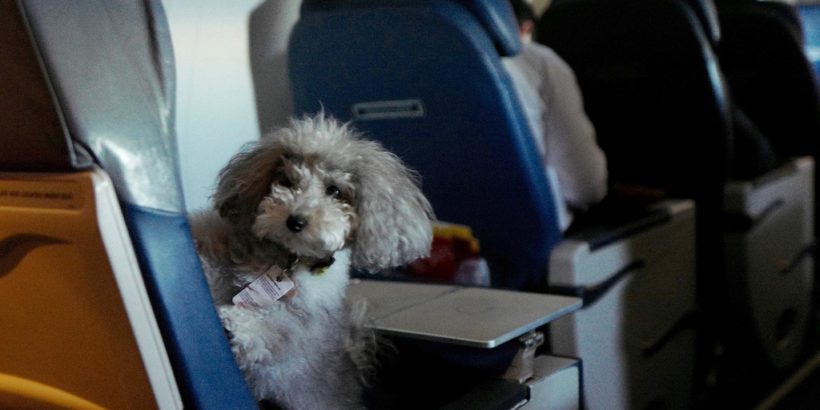

United Airlines Pet Policy (International, Cargo, Carry-on) [2023]
There are a few different United Airlines pet policies depending on how and for what purpose you’re bringing along your animals.
This article will take a detailed look at the pet policy for shipping animals on United.
I’ll cover in-cabin transport (carry-on), PetSafe (cargo), international, service animals, and show you where to go to get all of the forms and documents you’ll need to transport your animals.
Table of Contents
What is the United Airlines pet policy?
United Airlines will allow pets to fly in-cabin but they no longer offer the ability to fly pets in the cargo hold as part of the PetSafe program (except for limited exceptions for the military).
The pet policies require you to follow some very specific rules and guidelines so if you’re thinking about transporting your pets on United you need to pay very close attention to the different rules.
If you need to read more about United’s baggage policies in general you can do that here .
Tip: Use the free app WalletFlo to help you travel the world for free by finding the best travel credit cards and promotions!
How to avoid United pet fees
One of the easiest ways to avoid pet fees is to use the right credit card. The Capital One Venture Rewards Credit Card is a good card for general travel expenses and its points can be used to offset airline pet fees since they will often code as travel.
You can also use an incidental credit attached to a travel credit card. For example, the Platinum Card has a $200 incidental credit.
Other cards like the Chase Sapphire Reserve have a $300 travel credit that could be used on virtually any type of travel purchase including pet fees.
United in-cabin animals
In the past, United stated that they would allow domesticated cats, dogs, rabbits and household birds (excluding cockatoos) to travel accompanied in the aircraft cabin on most flights within the U.S.
They recently changed their website and now do not list out all of the different animals so it’s not clear to me what pets they allow beyond cats and dogs. For that reason, you may want to call and clarify what animals are allowed.
The fees for an in-cabin pet are $125 each way. Also, there is an additional $125 service charge for each stopover of more than four hours within the U.S. or more than 24 hours outside of the U.S.
Booking a ticket for your pet is very easy to do with United.
Whenever you are making a booking, just be sure to select “Travel with a pet” as a traveler. If you already made a booking, you can still go to My Trips and add a pet to an existing trip. You cannot add a pet using the United app.
Do everything you can to make this reservation in advance because there are limited slots available for pets on aircraft.
Whenever you arrive at the airport, be sure to check in and get your pet tag. Remember, you’ll need both your own and your pet’s confirmation numbers.
Also remember that your pet is expected to remain in the kennel while in the airport. If you need to take them to a relief area you can check the airport maps feature on the United app to see if you can find one.
Kennel rules
Before your bring your pet on-board, make sure that you are towing them in a kennel that complies with the United pet policy rules.
The kennel must fit completely under the seat in front of the customer and remain there at all times and the door needs to be secured as well.
Also, the animal must be able to stand up and turn and around inside the kennel. There may only be one pet per kennel.
There are also specific dimensions required for these pets:
- Hard-sided kennels : 17.5 inches long x 12 inches wide x 7.5 inches high (44 cm x 30 cm x 19 cm).
- Soft-sided kennels: 18 inches long x 11 inches wide x 11 inches high (46 cm x 28 cm x 28 cm).
United will allow you to bring along soft-sided pet carriers that slightly exceed these dimensions so long as they don’t block the aisle.
While your pet must remain under the seat, some people will purchase an extra seat because it makes it easier to deal with their pet.
For one, it gives the passenger space to put a personal item underneath the difference seat. It also allows them to more easily bend over to check on the animal.
No unaccompanied minors
Pets are not allowed to travel with unaccompanied minors .
Puppies and kittens traveling within the U.S. and Puerto Rico must be at least 2 months (8 weeks) old to be accepted for travel on United. Puppies and kittens traveling internationally must be at least 4 months (16 weeks) of age to be accepted for travel on United.
International travel
Pets are not permitted on flights to, from or through Australia, Hawaii, New Zealand and other locations. Please verify if your destination allows in-cabin pets prior to travel.
Rules for international in-cabin pets vary. To book international in-cabin travel for a pet, contact the United Customer Contact Center or call 1-800-864-8331 to add a pet to your reservation.
Health declarations
The Centers for Disease Control and Prevention (CDC) require all dogs entering the U.S., except those arriving from certain rabies-free countries , to be immunized against rabies.
Vaccinations must be completed at least 30 days before arrival in the U.S.
Since puppies cannot be vaccinated against rabies before 3 months of age, puppies under 4 months old will not be admitted into the U.S. unless they are arriving from a rabies-free country.
Each dog entering the U.S. must be accompanied by a valid certificate of rabies vaccination, signed by a licensed veterinarian and including the following information:
- Name and address of the dog’s owner
- Identifying information for the dog, including breed, sex, age, color and markings
- Date of vaccination and the name of the vaccine used
- Date when the vaccination expires. If no expiration date is stated, the vaccination must have been completed within 12 months before arrival in the U.S.
Visit the CDC website for more information.
Cats are not required to have proof of rabies vaccination for importation into the U.S; however, some states require vaccination of cats for rabies, so it is a good idea to check with state and local health authorities at your final destination.
Restrictions based on aircraft
You should note that there are some restrictions for specific types of aircraft that you’ll be flying on.
Keep in mind that many routes are served by different types of aircraft so you’ll always need to check and see exactly what type of aircraft you’re flying on.
You can do this be utilizing Google Flights or you can simply check on the United website.
Here are the restrictions:
- In-cabin travel for pets is booked on a space-available basis.
- A customer traveling with an in-cabin pet cannot be seated in the bulkhead or an emergency exit row .
- Two pets per flight are allowed in premium cabins on select aircraft. Pets are not permitted in premium cabins on Boeing 757, 767, 777 or 787 aircraft due to limited storage space under the seat.
- A customer traveling with an in-cabin pet in United Economy on Boeing 757-200 aircraft will need to be seated in a window seat due to limited storage space under aisle and middle seats.
- The number of in-cabin pets allowed varies by United Express partner airline.
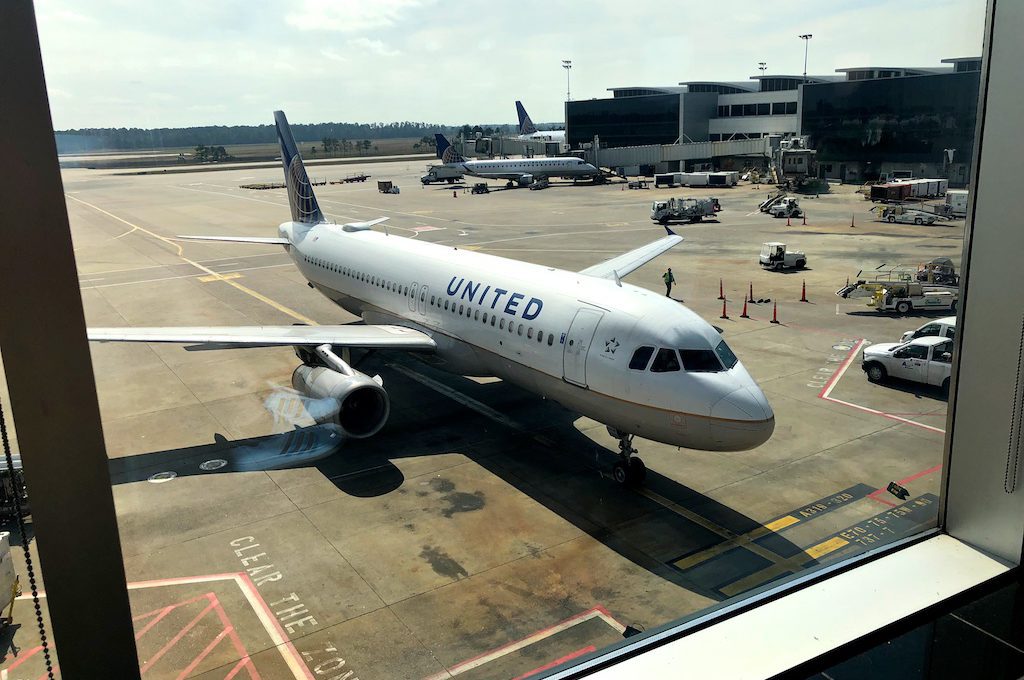
United PetSafe (cargo) [no longer available]
2023 Update: United no longer accepts PetSafe reservations.
United recently made changes to its PetSafe program so make sure that you’re up to date on all of the changes.
You can request your PetSafe booking here, but I highly advise that you read all of the details below before making a booking.
Puppies and kittens traveling within the U.S. and Puerto Rico must be at least 8 weeks of age to be accepted for travel on United.
Puppies and kittens weighing less than 2 pounds must be at least 10 weeks of age. International requirements can be complex, so please contact an International Pet and Animal Transport Association (IPATA) shipper for assistance.
Cats and dogs (breeds allowed)
Only cats and dogs are allowed
United will no longer accept reservations for the following brachycephalic (or short- or snub-nosed) dogs and cats and strong-jawed dog breeds:
- Affenpinscher
- American Bully
- American Pit Bull Terrier/Pit Bull
- American Staffordshire Terrier/”Amstaff”
- Belgian Malinois
- Boston Terrier
- Brussels Griffon
- American Bulldog
- English Bulldog
- French Bulldog
- Old English Bulldogges
- Shorty Bulldogs
- Spanish Alano/Spanish Bulldog/Alano Espanol
- Cavalier King Charles Spaniel
- English Toy Spaniel/Prince Charles Spaniel
- Japanese Chin/Japanese Spaniel
- American Mastiff
- Boerboel/South African Mastiff
- Bullmastiff
- Ca de Bou/Mallorquin Mastiff
- Cane Corso/Italian Mastiff
- Dogo Argentino/Argentinian Mastiff
- Dogue de Bordeaux/French Mastiff
- English Mastiff
- Fila Brasileiro/Brazilian Mastiff/Cao de Fila
- Indian Mastiff/Alangu
- Kangal/Turkish Kangal
- Neapolitan Mastiff/Mastino Napoletano
- Pakastani Mastiff/Bully Kutta
- Pyrenean Mastiff
- Presa Canario/Perro de Presa Canario/Dogo Canario/Canary Mastiff
- Spanish Mastiff / Mastin Espanol
- Tibetan Mastiff
- Tosa/Tosa Ken/Tosa Inu/Japanese Mastiff/Japanese Tosa
- Japanese Pug
- Shar-Pei/Chinese Shar-Pei
- Staffordshire Bull Terrier/”Staffys”
- Tibetan Spaniel
- Exotic Shorthair
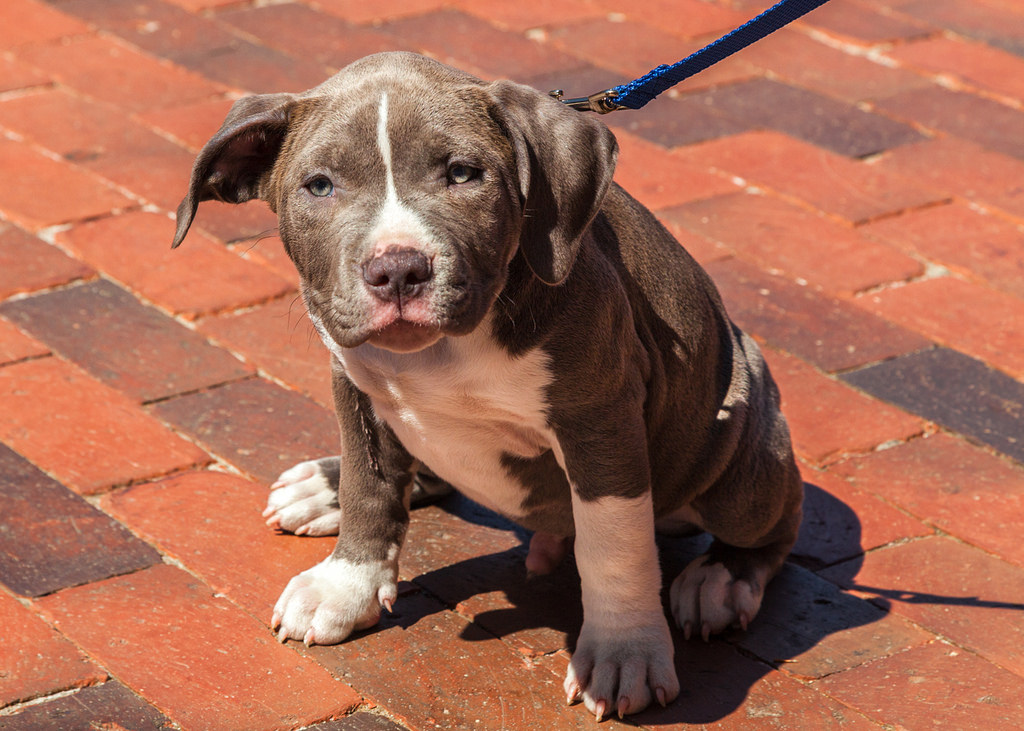
Temperature restrictions
United’s PetSafe program uses climate-controlled vans and keeps animals in holding areas within a temperature range of 45-85° F but United may decline to transport your pet if the outside temperatures are too extreme.
United will no longer accept reservations to and from the following airports annually between May 1 and Sept. 30 , due to high summer temperatures.
- Las Vegas (LAS)
- Palm Springs (PSP)
- Phoenix (PHX)
- Tucson (TUS)

Reservations
Reservations are accepted between 30 days in advance (maximum) and five (5) days (minimum) prior to travel
United will require you to submit several documents to United PetSafe prior to travel which include:
- Scanned copy of the completed, signed and dated Customer Acknowledgement Form
- Scanned copy of your pet’s Health Certificate from a licensed veterinarian dated within 10 days of travel (or the timeframe required by the destination country)
- Digital photo of your pet clearly showing their face to verify breed
- Digital photo of your pet’s travel crate to verify compliance with Petsafe’s crate requirements
You can find out more about these documents here .
No India or Australia
Not accept any reservations to and from India and Australia at this time
Connections
United will not accept PetSafe itineraries with more than three flight segments (or two connections).
Also, cats and dogs are required to have a comfort stop if the total length of their journey is more than 24 hours. However, you can purchase a comfort stop if you’re worries about your pet’s health on a long journey.
International routing
United requires international routing to be arranged through an International Pet and Animal Transportation Association (IPATA) pet shipper only. A list of IPATA members near you can be found at https://www.ipata.org
Crate guidelines
United will not accept a crate taller than 30″, including the 700 series crates. Also, they do not sell or lend crates at airports. Instead, crates can be purchased at united.com/petmate.
Find out more about the crate guidelines here.
If you need help selecting a good crate watch this .
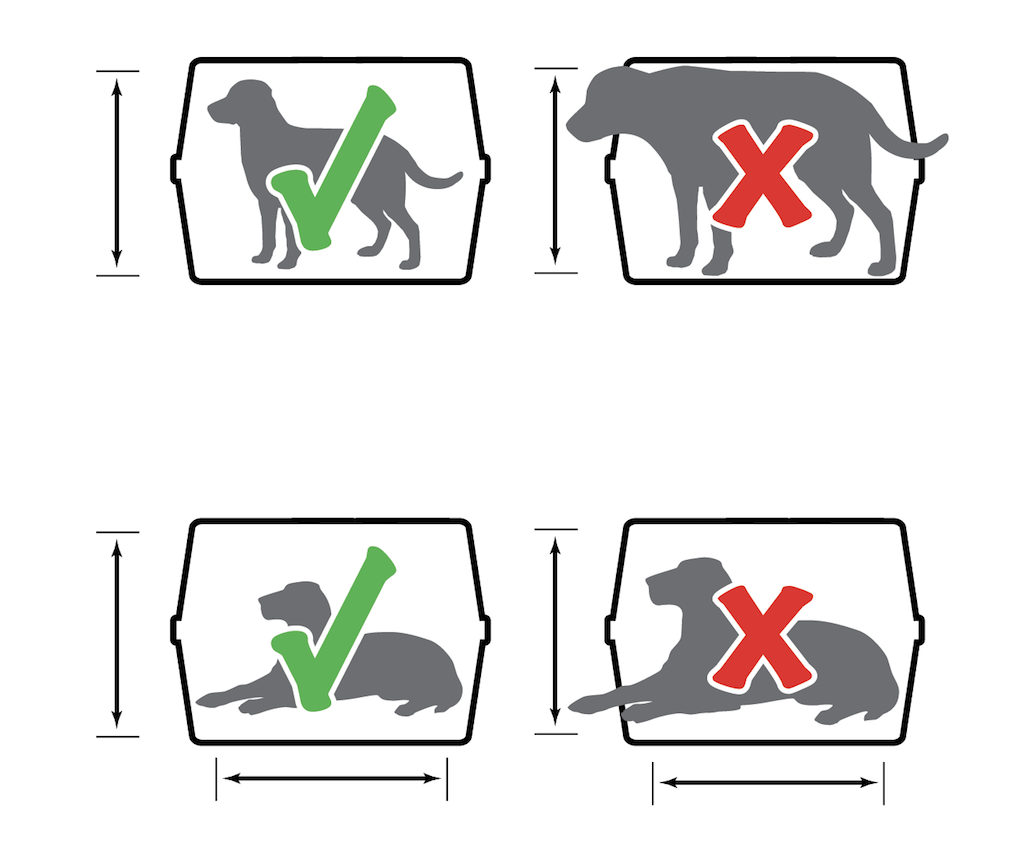
PetSafe Documents
United requests that you complete two forms.
One is a Customer Acknowledgment Form and the other is a Pre-Travel Checklist
I suggest that you print out both forms but for your reference here is the checklist:
Before you book (30 days prior to travel)
- Review new PetSafe acceptance policies
- Confirm your pet is acceptable for travel based upon age, breed, health and international travel restrictions
- Assess the overall health of your pet and if your pet is fit to fly
- Confirm the trip length and temperature is appropriate for your pet
- If you are shipping your pet internationally, engage an IPATA shipper for assistance with travel requirements and to make your booking
Preparing your pet for travel: Crate requirements (at least two weeks prior to travel)
- Review PetSafe Customer Pre-Travel Information Packet
- Obtain an airline-compliant crate that meets all guidelines and requirements
- Ensure crate is the appropriate size for your pet and does not exceed 30 inches in height
- Begin “crate acclimation” process as soon as possible to reduce your pet’s stress during travel
Preparing your pet for travel:
- Documentation and other requirements (5-10 days prior to travel)
- Fully complete and sign the Customer Acknowledgement Form
- Prepare digital copies of two photos to submit to PetSafe (one clearly showing your pet’s face to verify breed, one showing your pet’s travel crate to verify compliance with PetSafe’s crate requirements)
- Obtain the required Health Certificate from a licensed veterinarian within 10 days of travel (or the time frame required by the destination country)
- Required items include the Customer Acknowledgement Form, a Health Certificate from a licensed veterinarian, the photo of your pet and the photo of your pet’s crate
- Each attachment must be 2 MB or less and total email size cannot exceed 19 MB
Day-of-travel preparations
- Two copies of the signed and completed Customer Acknowledgement Form
- Print two copies of a photo of your pet, clearly showing your pet’s face (image should be no smaller than 3” x 3” and no larger than 4” x 6”)
- Health Certificate completed and signed by a licensed veterinarian
- Any additional required documents for travel / entry to the destination (for international travel, required documents should be confirmed by your IPATA shipper)
- Check unitedcargo.com for the drop-off location and time for your pet
- Prepare approved food and water containers for the inside of the crate
- Ensure that only allowable items are placed in or attached to the crate At the airport on travel day
- Confirm PetSafe drop-off location and time
- Arrive at least 30 minutes in advance of the minimum drop-off time to allow for processing
- Ensure person dropping off your pet has a current, government-issued photo ID to present at check-in
Tip: Check out the free app WalletFlo so that you can optimize your credit card spend by seeing the best card to use! You can also track credits, annual fees, and get notifications when you’re eligible for the best cards!
United Service animals
United Airlines has several different types of classifications for service animals and they have different regulations depending on the type of service animal.
Trained service animals
Trained service animals are animals that receive specific training to perform life functions for individuals with disabilities, such as:
- Visual impairments
- Mobility limitations.
Trained service animals are accepted in cabin for qualified individuals with a disability.
The service animal should sit in the floor space in front of the customer’s assigned seat but cannot protrude into the aisles. Customers may use an approved in-cabin kennel for smaller animals provided its use meets stowage requirements.
Exit row seating is prohibited.
Note that documentation may be required for an animal traveling to international destinations.
Emotional support animals and psychiatric service animals
Emotional support animals and psychiatric service animals that provide emotional, psychiatric or cognitive support for individuals with disabilities, but may or may not have task-specific training with respect to a disability.
Emotional support and psychiatric service animals are also accepted in cabin for qualified individuals with a disability if certain information and documentation are provided in advance of travel.
With prior documentation and clearance a customer may travel with no more than one emotional support animal.
Additional documentation beyond United’s requirements may also be required for an animal traveling to an international destination, Hawaii and other locations.
Customers traveling with an emotional support animal or a psychiatric service animal must provide the required documentation at least 48 hours before the customer’s flight by email ( [email protected] ).
Service animals in training
Animal trainers are permitted to bring one service animal that is training to assist disabled passengers onboard free of charge. These service animals must not occupy a seat. Trainers transporting service animals in the ordinary course of business or service animals who are not in training must check these animals.
Therapy animals
Therapy animals, which are pets that have been trained and registered by a therapy organization in order to visit nursing homes, hospitals, schools and other facilities, are not considered to be service animals.
When traveling with a therapy animal, standard pet-related regulations and restrictions will apply.
You can click here to read more about United service animals.
Customer service number
For questions, please contact the United Customer Contact Center number at 1-800-UNITED-1 (1-800-864-8331).
Is United Airlines safe for pets?
You might be wondering if it’s even safe to transfer your pet on United Airlines.
According to the DOT , United had the most animal deaths of all U.S. airlines in 2017 for the third year in a row on scheduled domestic or international passenger flights.
United had a total 18 deaths of animals in 2017, which amounts to 2.4 animal incidents per 10,000 animals transported in 2017. Delta Air Lines had 1 animal death in 2017 and American Airlines had 2 deaths of animals in 2017.
Since United has the wort track record in recent memory, I’d personally try to avoid transporting my furry friends with them in all honesty. But just in case you can’t avoid it, the odds are still very low that there will be an incident since we’re talking about 2.4 animal incidents per 10,000 transported animals.
Still, even with those odds some advise against transporting your animals in the cargo hold.
The Humane Society of the United States “strongly discourages” having your pet travel by air in the cargo hold of a plane, since the experience can be so stressful.
United Airlines Pet Policy FAQ
The fee is $125 each way for an in cabin pet.
You can use airline credits to avoid the fee with some credit cards such as the Amex Platinum Card.
No, an unaccompanied minors cannot travel with a pet.
United Airlines doesn’t allow in-cabin pets on flights to, from, or through: Australia Barbados Cuba Guam Federated States of Micronesia Hawaii Hong Kong Iceland Ireland Jamaica Marshall Islands New Zealand Norway Palau Panama Philippines Singapore South Africa Sweden Tahiti Trinidad and Tobago UK
Pets are not allowed in business class or first class on select aircraft including: Boeing 757-200, 767, 777 or 787.
As you can tell, there are a lot of restrictions and regulations for transporting pets on United flights. You should always be sure to check what the most up-to-date rules are since they can change from time to time.
Cover photo by Lynn Friedman via Flickr .

Daniel Gillaspia is the Founder of UponArriving.com and the credit card app, WalletFlo . He is a former attorney turned travel expert covering destinations along with TSA, airline, and hotel policies. Since 2014, his content has been featured in publications such as National Geographic, Smithsonian Magazine, and CNBC. Read my bio .
Privacy Overview

United Airlines Pet Policy: Comprehensive Guide to U.S. Airline Pet Policies
Learn about the United Airlines pet policy and other U.S. airlines’ pet policies for smooth travel with your pets. Updated for 2024.
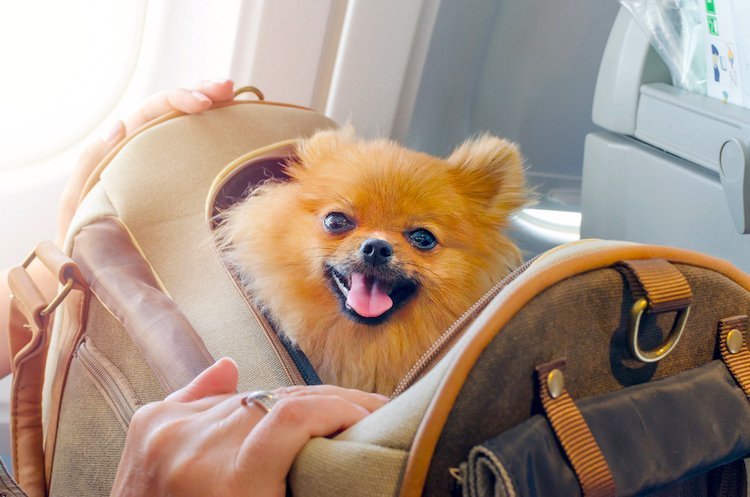
Editor’s Note (Updated June 2024): Airlines frequently update their pet policies. For the most up-to-date information, please check with your airline in advance. Even if an airline is not currently taking pets, they must still allow service and emotional support animals.
Introduction to United Airlines Pet Policy and Other U.S. Airlines
Humane travel: ensuring safe conditions for pets, choosing the right carrier for your pet, alaska air group, american airlines, delta air lines, frontier airlines, hawaiian airlines, jetblue airlines, southwest airlines, spirit airlines, united airlines, service animals and emotional support animals, handling layovers and delays, exotic pets, other important information, pet safety tips during air travel, our final thoughts on airline pet policies, frequently asked questions (faq).
Flying with a pet can be a stressful experience, particularly if it isn’t something you do often. Each airport has its own policies and quirks, and on top of that, each individual airline enforces different procedures.
To streamline the information, we’ve created this updated list of the airline pet policies for all major U.S. airlines, including the detailed United Airlines pet policy , as well as some helpful general knowledge, so flying with your pet isn’t such a headache.
For more tips on flying with pets , check out this comprehensive guide: Flying with a pet .
The International Air Transport Association (IATA) has compiled a list of requirements to ensure humane travel conditions for pets on all flights, regardless of the airline. These requirements address:
- Food and water
- Crate or carrier size and condition
- Ventilation
- Temperature
Airlines will refuse to allow your pet to fly if they feel the pet will be in unsafe conditions. Most airlines will not allow your pet to fly if they are in a kennel that is too small or if the pet is obviously sick or injured.
It’s important to review these guidelines when preparing to fly with your pet to ensure compliance and a safe journey.
Selecting the right carrier is crucial for your pet’s comfort and safety. Here are some key factors to consider:
- Size: Ensure the carrier is spacious enough for your pet to stand, turn around, and lie down comfortably.
- Ventilation: Choose a carrier with ample ventilation to ensure your pet gets enough fresh air.
- Comfort: Look for carriers with soft padding or the ability to add a blanket or bed.
- Safety Features: Secure latches and locks are essential to keep your pet safe.
- Airline Approval: Make sure the carrier meets the United Airlines pet policy and other airlines’ requirements for cabin or cargo travel.
- Material: Hard-sided carriers offer more protection, while soft-sided carriers can fit better under airplane seats.

Airline Pet Policies Overview
Contact: 1-800-252-7522 | Website
- Maximum number of pets: 1 carrier in the First-Class cabin, 5 carriers in the main cabin; 1 per passenger unless an adjacent seat is purchased, then a passenger may have 2.
- Price: $100 each way (cabin or baggage).
- Advance reservations: Recommended (holiday travel restrictions apply).
- Temperature restrictions: Pets may be refused if temperatures at any location on your itinerary “exceed certain limits,” which Alaskan Airlines does not specify. Other airlines have set limits of no hotter than 85 F (29.4 C) and no colder than 45 F (7.2 C).
- In the cabin: Dogs, cats, rabbits, and household birds.
- In cargo/baggage: Cats, dogs, ferrets, guinea pigs, hamsters, household birds, nonpoisonous reptiles, pot-bellied pigs , rabbits, and tropical fish. Other pets must receive advance approval. Only dogs and cats are permitted to be flown to Hawaii. Brachycephalic (short-nosed) dogs and cats are not accepted for travel in the cargo compartment on Alaska Airlines flights, but they may travel with you in the cabin as long as you have a carrier that fits under your seat.
- Hard-sided: 7.5″H x 17″L x 11″W
- Soft-sided: 9.5″H x 17″L x 11″W
- Up to 150 pounds. Full list of kennel requirements for cargo here .
Additional Notes:
- Pets are not permitted in the First-Class cabin or baggage compartment on Alaska Air’s Airbus planes.
- Alaska Airlines does not transfer pets to other airlines. You will need to pick up your pet after deplaning and recheck your pet on the new flight.
- Fur-st Class Care is an animal flight program with this airline that offers free pet health examinations and discounted health certificates at Banfield Pet Hospitals located in PetSmart stores.
Contact: 1-800-433-7300 | Website
- Maximum number of pets: 5–7 carriers per flight (depending on plane), 1 per person.
- Price: $125 each way (cabin); $200 each way (baggage).
- Advance reservations: Required.
- Destination restrictions: Domestic travel may not include Phoenix (PHX), Tucson (TUS), Las Vegas (LAS), or Palm Springs (PSP) during the period of May 1–Sept. 30.
- Temperature restrictions: No hotter than 85 F (29.4 C) at any location on your itinerary; no colder than 45 F (7.2 C). The cold-weather restriction may be waived at temperatures as low as 20 F (-6.6 C) if you bring a signed note from your veterinarian. Talk to the airline about this possibility.
- Allowed animals: Cats and dogs. Brachycephalic (short-nosed) dogs and cats are not accepted for the cargo compartment (checked pets).
- Carrier maximum size: Depends on the plane, so contact the airline in advance. The usual dimensions seem to be 9″H x 19″L x 13″W (with larger carriers allowed in cargo).
1-800-221-1212 | Website
- Maximum number of pets: 2 pets in the First-Class cabin, 4 pets in the main cabin, 1 per person. Space is limited.
- Price: $125 each way (cabin). Cargo price is determined by the size of the carrier. Animals are not included in the free baggage allowance.
- Advance reservations: Required but cannot be booked before 14 days before departure.
- Allowed animals: Small dogs, cats, and household birds (no birds allowed to Hawaii). No pit bull–type dogs in the cabin.
- Carrier maximum size: Determined by flight/type of plane. Contact the airline to determine cabin carrier size requirement. Baggage allows carriers of the dimensions 40″L x 28″W x 30″H, and cargo up to 32″L x 35″W x 48″H and 51 pounds.
1-800-432-1359 | Website
- Price: $75 each way (cabin only).
- Advance reservations: Recommended.
- Allowed animals: Dogs, cats, rabbits, guinea pigs, hamsters and small household birds.
- Carrier maximum size: 18″L x 14″W x 8″H
1-800-367-5320 | Website
- Prices: Cabin inter-island travel: $35. Cabin departing Hawaii travel: $175. No pets are allowed to travel in the cabin when arriving in Hawaii. Checked baggage: $60 (within Hawaii), $225 (when arriving or departing from North America). Cargo: Varies depending on weight of animal(s) + carriers. Call 1-800-367-5320 to discuss your specific needs.
- Advance reservations: Strongly recommended. For cargo, advance reservations are required.
- Allowed animals: Dogs, cats and household birds.
- Carrier maximum sizes: Cabin: 16”L x 10”W x 9.5”H; animal and carrier combined cannot exceed 25 pounds. Checked baggage: From 21”L x 16”W x 15”H and 18 pounds to 36”L x 24”W x 26”H and 70 pounds. Cargo: From 21”L x 15”W x 16”H and 26 pounds to 48”L x 32”W x 35”H and 277 pounds.
Note: We strongly recommend that you call Hawaiian Airlines directly to discuss your specific animal. Some animals cannot be shipped as cargo; others are prohibited from entering Hawaii.

1-800-538-2583 | Website
Was YOUR Pet Food Recalled?
Check Now: Blue Buffalo • Science Diet • Purina • Wellness • 4health • Canine Carry Outs • Friskies • Taste of the Wild • See 200+ more brands…
CHECK RECALLS NOW!

- Maximum number of pets: 4 per flight.
- Price: $125 each way (cabin only).
- Allowed animals: Dogs and cats.
- Carrier maximum size: 17″L x 12.5″W x 8.5″H, and the combined weight of pet and carrier must not exceed 20 pounds.
Note: Currently, JetBlue does not ship pets as cargo.
1-800-435-9792 | Website
- Maximum number of pets: 6 carriers per flight; 1 per person (carrier may contain 2 pets of the same species provided they both have room to comfortably turn around).
- Price: $95 each way (cabin only).
- Advance reservations: Required with an in-person payment at the ticket counter.
- Carrier maximum size: 18.5”L x 13.5”W x 8.5”H.
801-401-2222 | Website
- Maximum number of pets: 4 carriers per flight.
- Price: $110 each way (cabin only).
- Allowed animals: Dogs, cats and household birds (no farm poultry, waterfowl, game birds, birds of prey or flightless birds).
- Carrier maximum size: 18″L x 14″W x 9″H and cannot exceed 40 pounds.
1-800-864-8331 | Website
- Maximum number of pets: 2–4 per flight, depending on aircraft, and 1 carrier per person.
- Price: $125 each way (cabin); baggage and cargo rates are determined by size and weight of the carrier. Call United to discuss your pet’s needs before booking your trip.
- Allowed animals: Cats, dogs, rabbits and household birds (excluding cockatoos) are allowed in the cabin. Some breed restrictions apply to baggage/cargo animals for safety reasons .
- Carrier maximum size: 17.5”L x 12”W x 7.5”H (hard carriers), or 18”L x 11”W x 11”H (soft carriers).
Note: See United’s PetSafe Program for shipping animals as cargo.
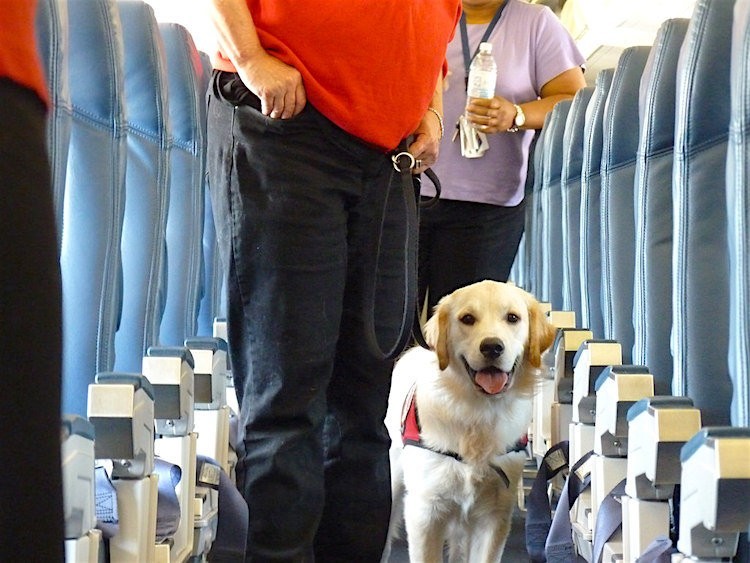
Almost all airlines, including those with policies like the United Airlines pet policy , allow properly documented service animals and emotional support animals (ESAs) to fly for free. Required documentation may include:
- Vaccination records (depending on where you are flying to/from)
- Letter from a mental health professional (ESAs only)
- Letter indicating the animal’s ability to refrain from “accidents” while in flight
- Proper harnesses, leashes, and restraints
- Correct visual aids identifying the animal as a service animal or ESA
Check with your airline to see its specific requirements, but be prepared to have the above documents in hand and answer questions at check-in. Most airlines require in-person check-ins at the ticket counter — you can’t use self-check-in or curbside services. Also, ask your airline about boarding early.
Be aware that even if your animal is designated a service or emotional support animal, they may not be allowed or may be quarantined immediately upon arrival at your destination.
All airlines warn that if the service animal or ESA acts in an uncontrollable, aggressive, or disruptive manner, they reserve the right to remove the animal and their handler from the flight. Be advised that because of the recent uptick in disruptive ESAs and so-called “fake service dogs” , many airlines are taking a tougher stance on these animals.
Most airlines, including American Airlines , allow passengers to buy an extra seat for their service animal or ESA, but otherwise, the animals may not sit in seats. Understanding these regulations will help when flying with pets .
Layovers and delays can be stressful for both you and your pet. Here’s how to manage them effectively:
- Plan Ahead: Check if the airports on your itinerary have pet relief areas.
- Stay Informed: Keep updated on flight status changes and communicate with airline staff about your pet’s needs.
- Essentials Pack: Bring a travel bag with pet essentials like water, food, a bowl, and waste bags.
- Comfort Breaks: Use layovers to take your pet to designated relief areas for a stretch and bathroom break.
- Calm Environment: Keep your pet calm with their favorite toy or blanket and stay close to provide reassurance.
Most airlines, including those following the United Airlines pet policy , do not accept exotic or unusual pets, regardless of their status. These may include:
However, this rule can apply to any animal. Call your airline and check the rules before booking a trip for you and your exotic pet .
Hawaii has restrictions of its own to adhere to because it is a rabies-free state and is stringent about what animals are allowed to enter.
Here are some more travel tips to follow when your pet joins you in the air:

When transporting pets, there are some consistent rules across all airlines:
- Temperature Limits: Airlines will not transport pets as baggage or cargo if temperatures drop below 10°F or exceed 85°F.
- Breed Restrictions: Brachycephalic (“short-nosed” or “flat-faced”) breeds of dogs and cats can’t fly as cargo or baggage. These breeds have trouble breathing at high elevations due to their shorter snouts.
- Time Limits: Check with your airline for time limits on flights longer than 8–12 hours or with layovers.
- Carry-on Policy: Pets count as your carry-on baggage, and you will pay the pet fee even if you have another carry-on item.
- Feeding: Give your pet food or water 4 hours before the flight. Feeding during the flight is usually not allowed.
- Sedation: Avoid sedating your pet unless absolutely necessary. The combination of elevation and sedation can cause health problems.
- Veterinary Proof: You must provide veterinary proof that your pet can fly. This includes a letter or certificate from a veterinarian within 10 days of departure and 30 days of return. Pets staying longer than 30 days need recertification.
- Lost Pets: Pets traveling as cargo or baggage can get lost, just like luggage.
- Kennel Labeling: Clearly label all kennels or carriers with your name, phone number, address, your pet’s name, and their medical information. Make sure to write “Live Animal(s)” visibly.
- Oxygen in Emergencies: Airlines will not provide oxygen to pets in emergencies.
- Age Requirement: Anyone accompanying a pet must be at least 18 years old.
- Early Check-in: Always prepare to check in early when traveling with a pet. Reserve a spot for your pet in advance if possible, as many airlines allow only a few pets in the cabin.
- Pet Age: Pets should be at least 8 weeks old and fully weaned.
- Embargoes: Several airlines have “embargoes” during the year, including when temperatures drop below or exceed safe levels and during the holidays.
Ensuring your pet’s safety during air travel is paramount. Here are some tips to keep in mind:
- Pre-Flight Preparation: Acclimate your pet to their carrier and take them on short trips to reduce anxiety.
- Check Temperature Restrictions: Follow the United Airlines pet policy on temperature limits to avoid health risks.
- Stay Hydrated: Provide water before the flight and use spill-proof containers.
- Avoid Sedatives: Avoid sedating your pet unless absolutely necessary, as it can pose health risks at high altitudes.
- Monitor During Flight: If possible, check on your pet during the flight. Ensure they are comfortable and not showing signs of stress.
There are many restrictions and regulations when it comes to transporting pets by air, but accidents still happen. The best defense your pet has is you:
- Educate Yourself: Learn what is expected from you, your pet, and the airline.
- Sign Up for Updates: If text message updates are available, sign up for them.
- Stay Informed: Keep track of what’s happening every step of the way to ensure your pet’s safe journey.
Understanding and following the specific United Airlines pet policy and other U.S. airlines’ pet policies will help make the process smoother and safer for your pet.
Can I bring my pet on board with United Airlines?
Yes, you can bring your pet on board with United Airlines, following their specific pet policy guidelines.
What are the temperature restrictions for flying with pets on American Airlines?
American Airlines will not allow pets to fly if the temperature at any point on your itinerary exceeds 85°F or falls below 45°F.
Are emotional support animals allowed to fly for free?
Yes, properly documented emotional support animals are typically allowed to fly for free on most airlines.
Don’t leave your pet’s food safety to chance.
Sign up for petful’s recall alerts today. (it’s 100% free.).
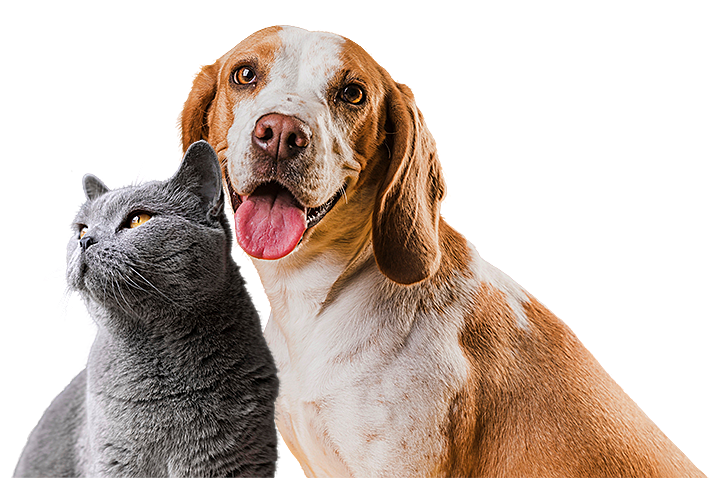
Stay informed. Protect your pets.
Meet Petful
- How We Help
Pet Food Safety
- Free Recall Alerts
- Pet Food Recalls
- Report Problems
- Vet-Approved Recipes
- Adopt a Pet
- Privacy Policy
- Cookie Policy
- Terms & Conditions
- Takedown Policy
© 2024 Petful® / P51 Capital All rights reserved. Petful does not provide medical advice, diagnosis or treatment. More information.
Simple Flying
Explained: united airlines' pet policy.

Your changes have been saved
Email is sent
Email has already been sent
Please verify your email address.
You’ve reached your account maximum for followed topics.
- United Airlines does not allow pets to be checked in as cargo, except for US military and State Department personnel traveling between Honolulu and Guam.
- Travelers can bring their pets in-cabin for a fee of $125 each way, but there are size restrictions, and pets must remain in their carriers throughout the flight.
- Traveling internationally with pets on United Airlines can be challenging, as specific rules and restrictions depend on the destination.
With travel demand soaring over the past few months , more and more people are looking to travel with their pets. However, rules on traveling with pets can be tricky, and they can be very different from one airline to another.
United Airlines is not known to be the most pet-friendly airline in the sky. In fact, NerdWallet ranked United last out of the nine major US carriers in terms of pet-friendliness. So, what exactly are the rules for traveling with pets on United Airlines flights?
No pets in cargo
To start, it is essential to note that United Airlines does not allow pets to be checked in . The carrier stands out as one of the few airlines in the US not to have a program that facilitates checking pets into the cargo hold as checked luggage.
Some might be familiar with the PetSafe program United used to have, which allowed some pets to be checked in as cargo on United-operated flights. However, the program has been suspended and has yet to make a comeback, so it has proven to be a challenge for some travelers who wish to travel with their furry friends.
There is a single exception to the rule. If you are a US military or State Department personnel traveling between Honolulu and Guam on a flight operated by United Airlines, you are in luck. Qualified travelers can transport their pets as checked baggage on flights between the two cities with a few limits and rules .
Traveling with pets in-cabin
When it comes to traveling with pets in the cabin, there are a series of rules to follow. Before traveling, travelers need to choose the 'travel with pets' option when booking and ensure that their pets are over two months old if traveling domestically and over four months old when traveling internationally. It can also be added as an additional option later on, and there is a $125 fee each way for traveling with pets.
There are some size restrictions on pet carriers, and the pets must be able to stand up and move around. Once on the plane, the pet carrier goes under the seat, and pets must not be let out at any time. Last year, a cat escaped on a United flight from Dallas and wandered around the cabin.
Internationally, it can be tricky as travelers must adhere to local rules and are often required to complete additional paperwork. For example, it is not possible to travel with pets to a number of countries that United flies to, including the UK, Australia, Brazil, Ireland, and several more. It is best to check United's "Flying with Pets" page before traveling to keep up with the latest rules.
Your Stress-Free Guide To Traveling With Furry Friends
Flying with pets doesn't have to be a trial — it can be simple, easy, and even fun if you know how! Here’s our guide to flying with pets.
What about service animals?
On United Airlines, service animals can fly for free with their owner or trainer if they are over four months old. Travelers flying with service animals must indicate their choice after booking through United's website and fill out several DOT forms. More information can be found on United Airlines' page on service animals.
- North America

United Airlines Pet Policy

Navigating the Skies with Your Furry Friend: A Guide to United Airlines’ Pet Policy
Traveling with your pet can be an exciting adventure, but navigating airline pet policies can feel like deciphering a foreign language. If you’re considering taking your furry friend on a trip with United Airlines, worry not! This comprehensive guide will untangle United’s pet policy, ensuring a smooth and stress-free travel experience for you and your four-legged companion.
Table of Contents
Can My Pet Fly in the Cabin with Me in United Airlines?
United Airlines prioritizes pet safety and passenger comfort. Therefore, only cats and dogs are permitted to travel in-cabin, subject to space availability. United doesn’t allow any other pets on board.
Meeting the In-Cabin Criteria
For your pet to fly comfortably at your feet, they must meet these requirements:
- Age: Pups and kittens must be at least 4 months old for international flights and 8 weeks old for domestic flights within the United States.
- Hard-sided kennels: maximum dimensions of 17.5 inches long x 12 inches wide x 7.5 inches high (44 cm x 30 cm x 19 cm)
- Soft-sided kennels: maximum dimensions of 18 inches long x 11 inches wide x 11 inches high (46 cm x 28 cm x 28 cm)
Important Note: Each passenger is allowed a maximum of one pet carrier in the cabin . However, if you’d like to bring two pets, you can purchase an additional seat to accommodate the second pet carrier.
Booking Your Pet’s Spot on the Plane
Since pet travel is subject to space availability, it’s crucial to make reservations for your pet well in advance, especially during peak travel seasons. Here’s how to secure your pet’s spot:
- Contact United Reservations : Call United Reservations as soon as you book your flight to confirm pet acceptance on your chosen route and date.
- Provide Pet Information: Be prepared to share your pet’s breed, weight, and dimensions during the reservation process.
- Pay the Pet Fee: United charges a one-way fee of $125 for in-cabin pet travel. There’s an additional $125 fee for layovers exceeding 4 hours domestically and 24 hours internationally.
Preparing Your Pet for Takeoff
To ensure a calm and comfortable flight for your pet, here are some pre-flight preparations to consider:
- Acclimation to the Carrier: Familiarize your pet with their carrier well before the flight. Leave it open in a familiar location with comfy bedding and treats to encourage them to explore it voluntarily.
- Veterinarian Visit: Schedule a vet checkup to ensure your pet is healthy enough for air travel. Discuss any potential concerns you might have and obtain a health certificate if necessary (usually required for international travel).
- Fasting and Hydration: Withhold food for a few hours before the flight to prevent nausea. However, ensure your pet has access to water throughout the travel day.
Restricted Items for In-Cabin Pets
While your pet can have a comfy bed and a favorite toy in their carrier, some items are strictly prohibited in the cabin:
- Food and water bowls (removed during takeoff and landing)
- Leashes, collars (can be attached to the carrier for identification purposes)
- Live animals other than approved service animals
Service Animals vs. Pets
United differentiates between service animals and pets. Service animals trained to assist people with disabilities are exempt from fees and can travel free of charge in the cabin, but specific requirements and documentation are necessary. Always check with United for the latest guidelines on service animal travel.
Alternatives to In-Cabin Pet Travel
If your pet doesn’t meet the in-cabin criteria or you prefer not to have them in the cabin, United does not offer pet travel in cargo for most passengers. However, exceptions exist for active military personnel on permanent change of station orders and Foreign Service personnel on reassignment, under specific circumstances.
Beyond the Basics: Additional Tips for a Smooth Flight
Here are some bonus tips to ensure a positive travel experience for you and your pet:
- Label your pet carrier clearly with your contact information .
- Take your pet for a bathroom break before boarding .
- Avoid feeding your pet right before or during the flight .
FAQ’s
Yes, but with limitations. United Airlines only allows cats and dogs to travel, and only in the cabin (not as checked baggage). There’s also limited space available, so booking in advance is crucial.
There’s a $125 fee per pet, each way, for in-cabin travel. If your layover exceeds 4 hours domestically or 24 hours internationally, an additional $125 fee applies.
Puppies and kittens must be at least 8 weeks old for domestic flights and 4 months old for international flights. The pet carrier dimensions are: Hard-sided carriers: maximum 17.5 x 12 x 7.5 inches (44 x 30 x 19 cm) Soft-sided carriers: maximum 18 x 11 x 11 inches (46 x 28 x 28 cm) The carrier must fit comfortably under the seat in front of you.
You cannot book pet travel directly through the online booking system. Call United Reservations after booking your flight to confirm pet acceptance on your chosen route and date. Be prepared to provide pet information and pay the pet fee during this call.
A health certificate might be required for international travel. It’s best to consult your veterinarian for the latest guidelines. For domestic flights within the US, typically no documentation is needed beyond ensuring your pet meets the age and carrier requirements.
Related Posts

Turkish Airlines Pet Policy

American Airlines Pet Policy

Delta Airline Pet Policy

Hawaiian Airlines Pet Policy

Southwest Airlines Pet Policy

Spirit Airlines Pet Policy
- Skip to main content
- Skip to primary sidebar
Additional menu

The Pet Friendly Vacation Guide

United Airlines Pet Policy: Everything You Need to Know Before Flying With Your Dog or Cat
posted on March 12, 2023 by James Brockbank | Last updated on March 13, 2023
As a pet owner, you might consider traveling with your furry companion on an airplane. However, you must be aware that there may be certain restrictions and guidelines that you need to know before making any travel arrangements.
Suppose you’re interested in understanding airlines’ policies and procedures for pets, including any size or breed restrictions, fees, and required documentation. In that case, you can learn everything by reading this article about the United Airlines pet policy.
You will also learn about the options available for pet travel, such as in-cabin or cargo hold, and any specific requirements for service animals. Overall, we have all the necessary information to ensure you have a safe and comfortable travel experience for yourself and your pet.
Size & breed restrictions
Required documentation, age requirements, making a reservation, petsafe partnership, emotional support pets, types of pets allowed, number of pets allowed, route restrictions, service animals, traveler tips, united airlines pet policy.
United Airlines allows pets to travel in the cabin on most flights within the U.S. and to select international destinations, as well as in the cargo hold on many of its flights.
United Airlines have specific size and breed restrictions for pets traveling in the cabin, and there are fees for each service. In addition, customers must provide a veterinarian health form for their pet and book in advance.
For pets traveling in the cargo hold, United Airlines has specific guidelines and regulations that must be followed to ensure the safety and comfort of the animal.
It’s important to note that service animals have different policies and procedures, so it’s best to check with the airline directly if you plan to travel with a service animal.
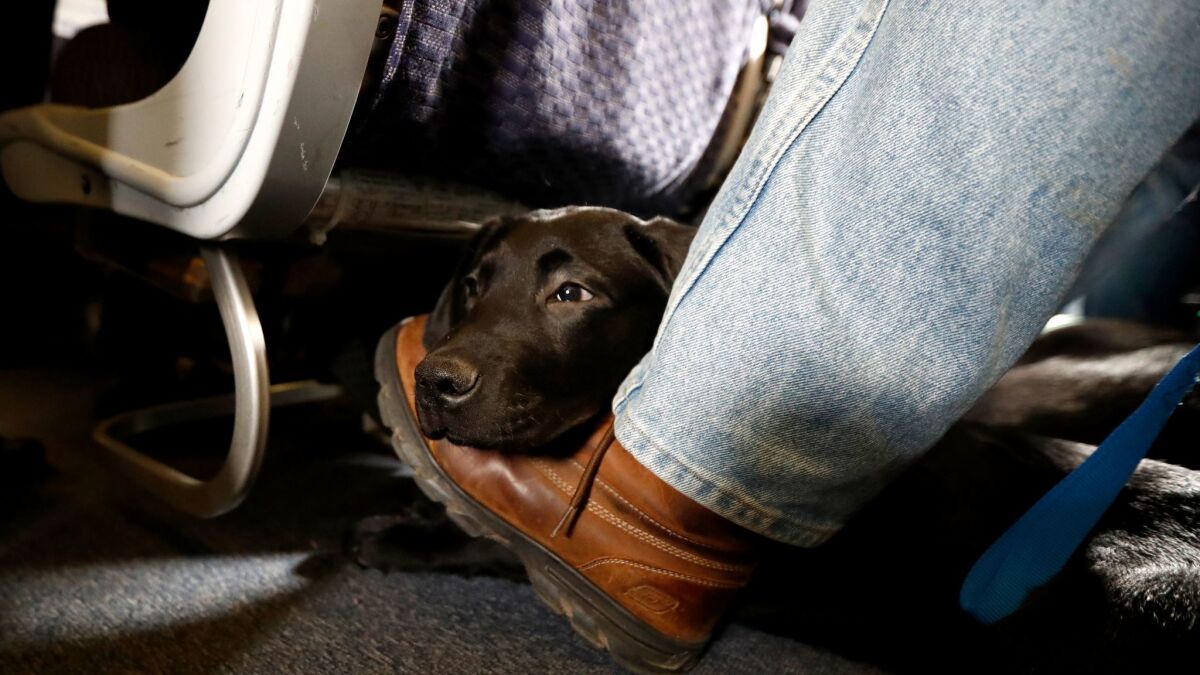
When it comes to traveling in the cabin with your pet on United Airlines, there are a certain size and breed restrictions that you need to know.
The airline only allows small cats and dogs that can fit comfortably in a carrier under the seat in front of you. The carrier must not exceed the dimensions of 9 inches high x 18 inches wide x 14 inches deep.
The airline has a list of breeds that are not allowed to travel in the cabin; these breeds include American Pit Bull Terrier, American Staffordshire Terrier, Bull Terrier, Bulldog, Chinese Shar-pei, Dogo Argentino, Fila Brasileiro, Japanese Tosa, Pit Bull, Presa Canario, Rottweiler, and Staffordshire Bull Terrier. The airline also doesn’t accept the following cat breeds: Exotic Shorthair, Persian, Himalayan, and Burmese.
Additionally, United Airlines only allows one pet carrier per passenger and a maximum of two pet carriers per flight. So, ensure to book your flight in advance and check for the availability of traveling with your pet.
Larger pets or those that not meeting the size and breed restrictions for in-cabin travel can travel in the cargo hold. However, it’s important to note that it’s not as comfortable as traveling in a cabin.
Additionally, the cargo hold option is not available on all flights or destinations, and checking with the airline directly for availability is recommended.
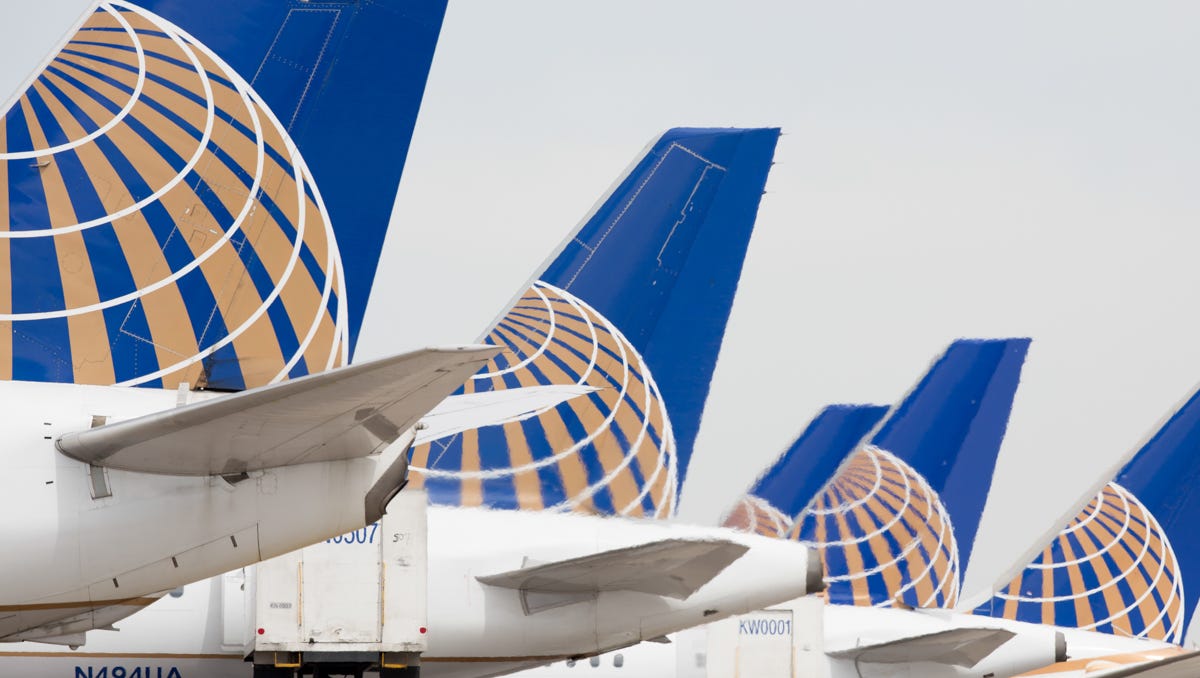
United Airlines charges a fee for passengers who bring their pets on board and in the cargo hold.
It’s important to note that these fees are subject to change and may vary depending on the destination and class of service. Additionally, additional fees and taxes may be imposed by certain countries for international travel.
United Airlines pet policy requires certain documentation for traveling with a pet on its flights. The following are some of the required documents:
It is important to note that these requirements are also subject to change and may vary depending on the destination and class of service. It’s best to check with the airline directly and get the most up-to-date information on the required documentation before making any travel arrangements with your pet.

United Airlines has some age restrictions for pets traveling on the flights.
Pets less than eight weeks old are not accepted for travel on the airline. Pets older than eight weeks, but less than six months old, are not accepted for travel on a case-by-case basis. Customers must provide a veterinarian’s statement certifying that the pet is healthy enough to travel.
Additionally, pets over the age of seven years old must have a veterinary certification of good health within the past 10 days before travel.
United Airlines has a partnership with PetSafe , a program that offers specialized travel options for pets that cannot travel in the cabin or cargo hold. The program is designed to provide safe and comfortable travel options for pets that are large, have certain medical conditions, or are of certain breeds.
Through the PetSafe program, United Airlines can offer various travel options for pets, including ground transportation, temperature-controlled facilities, and flights on specially equipped aircraft. The program provides additional services such as pre-flight veterinary consultation and post-flight follow-up.
To book a PetSafe flight, you need to contact United Airlines’ PetSafe Desk at 1-800-575-3335, where a specialist will help determine the most appropriate travel option for your pet.
You can only book a PetSafe flight for a certain origin and destination; thus, checking with the airline for availability and restrictions is recommended.

United Airlines has specific restrictions for emotional support animals on their flights. Only one emotional support animal per passenger is allowed; the animal must be a dog or cat at least four months old. The animal must be well-behaved and cannot threaten other passengers’ health or safety.
Passengers must provide documentation from a mental health expert declaring that the passenger’s mental health and well-being need the animal, a veterinary health form, and a signed statement of responsibility for the animal. The animal must also be trained to behave in a public setting.
United Airlines reserves the right to deny transportation to any animal that appears too large or too heavy to be accommodated in the cabin or poses a direct threat to the health and safety of others.
United Airlines pet policy allows various pets to travel with passengers on their flights, including cats, dogs, household birds, and small household animals such as rabbits, guinea pigs, and hamsters.
However, each type of pet is subject to different guidelines and restrictions. Cats and dogs can travel as either carry-on or checked baggage but must be in a carrier that meets United Airlines’ requirements.
Household birds must be in a cage that meets United’s guidelines and can travel as either carry-on or checked baggage. Small household animals such as rabbits, guinea pigs, and hamsters can also travel as carry-on or checked baggage if they meet United’s guidelines.
It’s important to check the airline’s official website to read the most up-to-date information concerning these guidelines for traveling with pets.
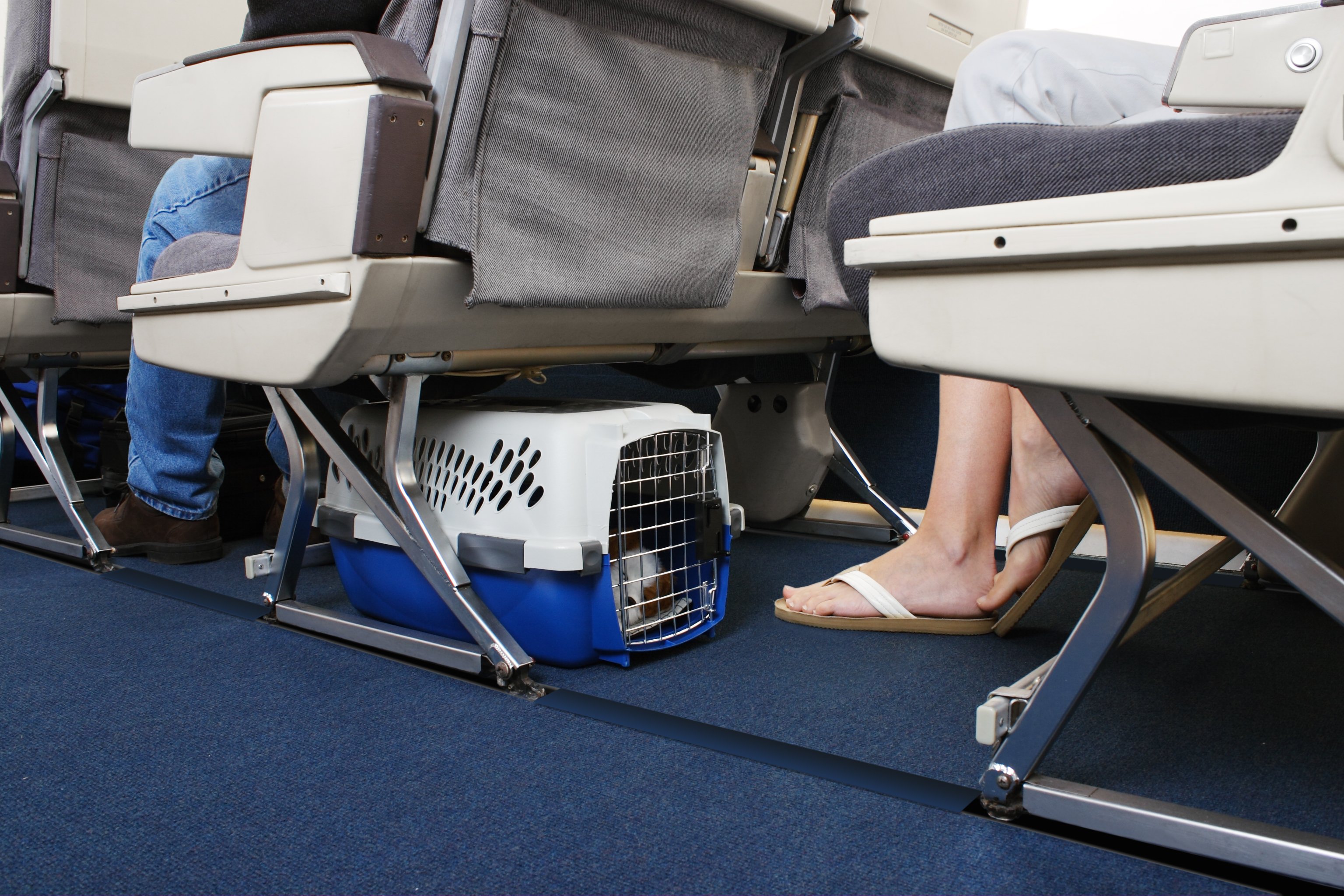
United Airlines allows a limited number of pets to travel with passengers on their flights. The number depends on the type of pet and the specific flight. For example, for cats and dogs, United Airlines generally allows up to two per passenger, with one pet per carrier.
For household birds and small household animals, the number allowed may be less, depending on the flight you’re taking. If you have multiple pets you want to travel with, checking out United Airlines’ “PetSafe” program might be the best option.
It is more flexible and allows more pets than regular travel but may have different rules and restrictions.
United Airlines has certain route restrictions when it comes to traveling with pets. Not all destinations or flights accept pets; certain destinations may have additional restrictions or regulations.
For example, flights to Hawaii, certain international destinations, and United’s Basic Economy fare do not accept pets. Additionally, pets are not allowed on flights operated by United Express, which are flights operated by regional partners.
These regulations may vary, so checking United Airlines’ website for the newest information is best. Also, some destinations may have specific restrictions or regulations regarding the importation of animals, and it’s the passenger’s responsibility to comply with those regulations.
It’s important to note that during hot weather months, United Airlines may restrict the acceptance of pets in the cabin or cargo for certain flights depending on the destination to ensure the animal’s safety.
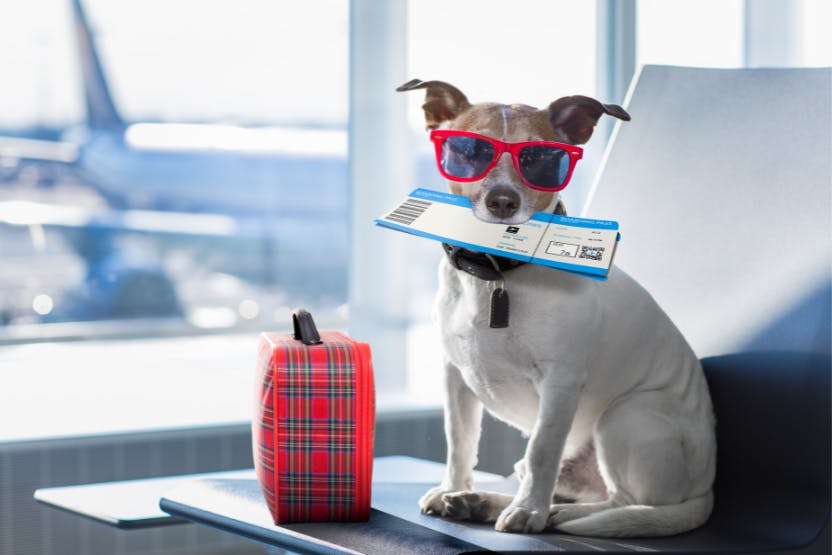
United Airlines has specific regulations for passengers traveling with service animals. Animals specially trained to carry out duties or work for people with impairments are referred to as service animals. Under the Air Carrier Access Act, United Airlines must allow travelers with impairments to travel with service animals.
Service animals are allowed in the cabin with the passenger at no additional cost. United Airlines does not require documentation for service animals but may ask for documentation to confirm that the animal is a service animal and the task it has been trained to perform.
Passengers traveling with service animals must also ensure that the animal is well-behaved and does not directly threaten other passengers.
Here are a few recommendations to help you prepare a pet-friendly travel kit.
- Don’t forget to bring all the essentials needed to care for your pet while you’re still at the airport. This includes the leash, treats, water bowl, and plastic bags.
- Always bring your pet’s favorite toy, blanket, or anything of the sort, to keep them calm during the flight.
Overall, United Airlines pet policy is designed to provide a safe and comfortable travel experience for you and your pet.
It’s important to gather all the necessary information and make all the required arrangements before your trip to ensure a smooth travel experience. We hope that we’ve helped you learn more about animal policies with this article, and if anything is unclear, you can find more information on the airline’s official website .
Reader Interactions
Leave a reply cancel reply.
Your email address will not be published. Required fields are marked *
Save my name, email, and website in this browser for the next time I comment.
- Credit cards
- View all credit cards
- Banking guide
- Loans guide
- Insurance guide
- Personal finance
- View all personal finance
- Small business
- Small business guide
- View all taxes
You’re our first priority. Every time.
We believe everyone should be able to make financial decisions with confidence. And while our site doesn’t feature every company or financial product available on the market, we’re proud that the guidance we offer, the information we provide and the tools we create are objective, independent, straightforward — and free.
So how do we make money? Our partners compensate us. This may influence which products we review and write about (and where those products appear on the site), but it in no way affects our recommendations or advice, which are grounded in thousands of hours of research. Our partners cannot pay us to guarantee favorable reviews of their products or services. Here is a list of our partners .
United Airlines Pet Policy: What You Need to Know
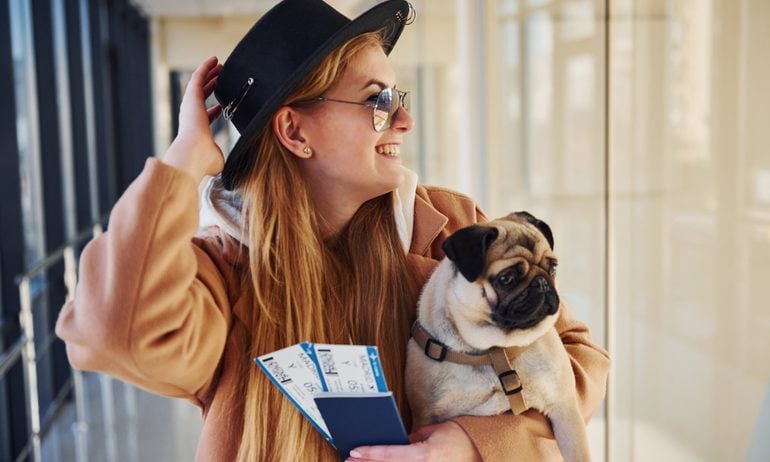
Many or all of the products on this page are from partners who compensate us when you click to or take an action on their website, but this does not influence our evaluations or ratings. Our opinions are our own.

Table of Contents
The United Airlines pet policy
United in-cabin pet options, most pet-friendly airlines, final thoughts on the united pet policy.
Heading out on a vacation sounds good, doesn’t it? After all, there’s not much else like sipping a daiquiri on the beach. But there’s an extra step to take before traveling when you’ve got pets at home. Do you opt for a pet sitter, find a doggy hotel or bring your furry friend along with you?
Plenty of airlines allow you to travel with pets, whether that’s in the cabin or as cargo. Let’s take a look at United Airlines’ pet cargo policy, its in-cabin options and how flying pets with United compares to other airlines.
The United pet policy does not allow pets to fly in cargo, unless you qualify for an exception with the U.S. military or foreign service. These are the limited circumstances in which it’s possible to travel with a pet in cargo on United:
Active duty U.S. military traveling on permanent change of station orders can fly pet cats and dogs between Honolulu and Guam.
Foreign Service Personnel traveling on current reassignment have the same privileges.
Prior to 2018, United Airlines operated its PetSafe program, which allowed customers to bring their pets along as cargo on eligible flights.
However, the program has been completely suspended since then. To date, United has opted not to resume operations.
» Learn more: How to fly with a dog
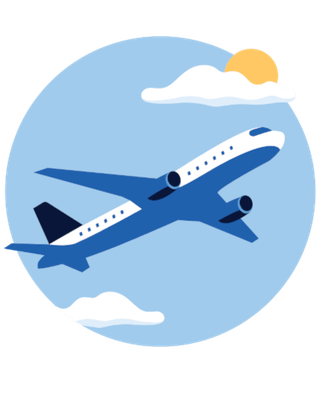
Since United doesn’t operate its PetSafe program anymore, your options are pretty limited when it comes to traveling with your pet. It’s still possible to travel with a pet in cabin as a piece of carry-on luggage under the seat in front of you, if they meet the specific requirements:
You can only travel with cats and dogs.
Animals must be able to fit comfortably inside their kennel, which cannot exceed a certain size .
Kittens and puppies must be at least two months old (for domestic flights) or four months old (for international flights).
Pets cannot travel with unaccompanied minors.
You must travel with your pet.
Traveling with an in-cabin pet is limited to certain destinations and certain cabins.
If you purchased your fare before April 26, 2024, United charges $125 each way to bring your pet along with you in the cabin, although you’ll be on the hook for an additional $125 if your layover is long. Domestic layovers of more than four hours and international layovers of more than 24 hours will charge this extra fee.
If you bought your ticket on or after April 26, 2024, you'll pay a $150 fee each way.
» Learn more: 3 C’s simplify complex rules for flying with pets
In our most recent analysis on flying with pets , we ranked the major U.S. airlines on various factors including fees, types of animals allowed, whether you can bring pets in cargo and number of pets allowed per passenger, among other facrtors.
Here's how they stacked up:
» Learn more: The best hotels that allow pets
United suspended the ability to fly with your pet in cargo in 2018 after a number of high-profile incidents. Since then, it has failed to revamp the PetSafe program, leaving United customers out of luck when it comes to their larger four-legged friends. But those whose pets can fit under the seat can still take advantage of flying with their animals inside the cabin.
How to maximize your rewards
You want a travel credit card that prioritizes what’s important to you. Here are some of the best travel credit cards of 2024 :
Flexibility, point transfers and a large bonus: Chase Sapphire Preferred® Card
No annual fee: Wells Fargo Autograph℠ Card
Flat-rate travel rewards: Capital One Venture Rewards Credit Card
Bonus travel rewards and high-end perks: Chase Sapphire Reserve®
Luxury perks: The Platinum Card® from American Express
Business travelers: Ink Business Preferred® Credit Card
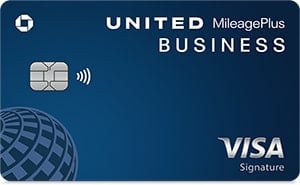
on Chase's website
1x-2x Earn 2 miles per $1 spent on United® purchases, dining, at gas stations, office supply stores and on local transit and commuting. Earn 1 mile per $1 spent on all other purchases.
75,000 Earn 75,000 bonus miles after you spend $5,000 on purchases in the first 3 months your account is open.


United: Pet Policy
- Planes & Seat Maps
What methods of transport does United Airlines provide for my pet?
- Travel in the passenger cabin.
- Checked as baggage in pressurized and temperature controlled area of your aircraft.
- Shipped as cargo in pressurized and temperature controlled area.
Does my pet qualify for travel in the passenger cabin?
Pets that meet the following qualifications can travel in the passenger cabin:
- Only domesticated dogs, cats or household birds (canary, finch or parakeet) may be accepted as carry on baggage.
- Pets must be at least 8 weeks old.
- Dogs and cats must be fully weaned.
- You are not traveling to, from or through Hawaii or Guam.
- Your pet can comfortably remain in its kennel, under the seat for the entire flight.
- The kennel is specifically made for animal carriage and can fit under the seat.
- Your pet has all necessary health documents required by your destination (see below for more information).
- Pets are not permitted to travel in the cabin on flights to/from Australia (exceptions may be made for service dogs such as seeing-eye or guide dogs).
- Pet must be traveling on the same flight as the owner.
More restrictions may apply. Please visit the In-cabin pets page on the United website for more information.
Does my pet qualify for travel as checked baggage?
Pets that meet the following qualifications can travel as checked baggage:
- Only domesticated dogs, cats, household birds (canary, finch or parakeet), rabbits, hamsters, and guinea pigs may be accepted as checked baggage.
- Dogs and cats must be at least 8 weeks old.
- The kennel meets all requirements (see below for more information).
- Pets are not permitted to travel as checked baggage on flights to/from Australia (exceptions may be made for service dogs such as seeing-eye or guide dogs).
- Due to extreme heat, United Airlines will not accept any pets as checked baggage for travel to/from Kuwait (KWI) or Bahrain (BAH) from May 1 through September 30.
Does my pet qualify to be shipped as cargo?
If your pet does not meet the requirements for travel in the cabin or as checked baggage, or if you would like your pet to travel unaccompanied, contact United Airlines Cargo at 1-800-UA-CARGO for more information.
What are the fees associated with pet transport?
- Transported in cabin for travel within the U.S., Canada and U.S. territories: $125
- Kennel fees vary depending on the size. Click here for more information.
Contact United Airlines Reservations for rates to/from Japan and Brazil.
What are the kennel requirements?
In addition to the size and weight maximums, the USDA and United Airlines require that kennels meet the following requirements:
- Be leak-proof and escape-proof.
- Be properly ventilated, but not allow any part of the animal from protruding outside of the container.
- Provide enough room for the animal to stand and turn around.
- Be made of metal, wood, or a hard plastic/composite.
- Contain absorbent material or litter.
- Have functional handles on the kennel's exterior to prevent tilting and any direct contact with the animals.
- Be closed securely, but not locked.
- Have labels with the words "Live Animal" in letters at least 1-inch tall on the crate's top and on at least one side.
- Have upright arrow labels indicating kennel's correct position.
What health documentation is required?
Passengers are required to make sure all health and pet travel documents are current and compliant with local, state, federal and international entry requirements and regulations. The passenger assumes full responsibility for penalties assessed by agencies for non-compliance of pet health and entry requirements.
Are there any other restrictions?
United Airlines can refuse to transport an animal due to illness, aggressive behavior, poor kenneling, or extreme temperatures at origin, transfer, or destination airports. Short-nosed dog breeds are not accepted for travel as checked baggage or cargo from June 1 - September 30.
Please contact the airline directly for information about traveling with a service animal.
SeatGuru was created to help travelers choose the best seats and in-flight amenities.
Pet-friendly airlines: The best airlines for pets in the US
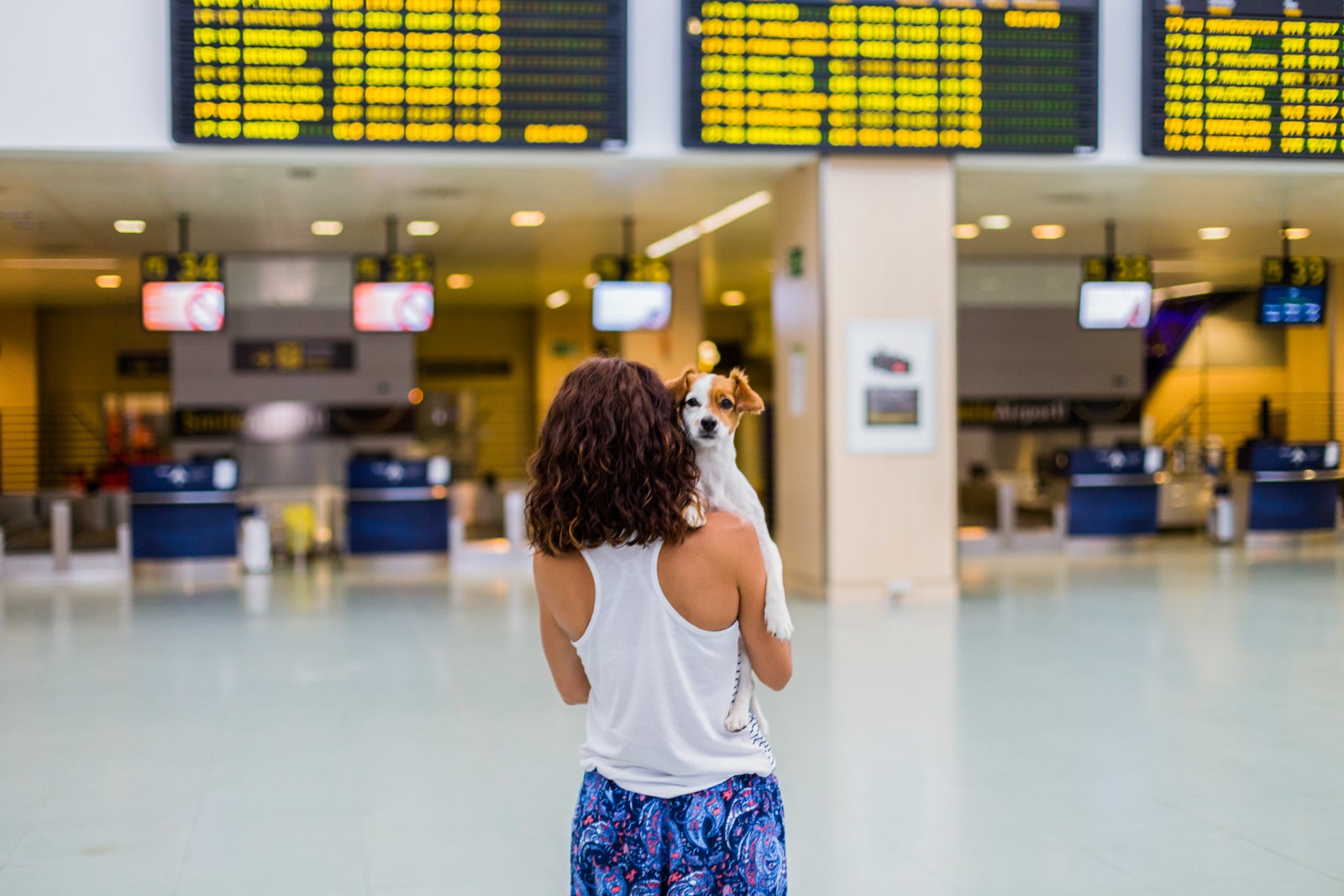
With pet travel so in vogue these days, there's no need to not pack your pup the next time you catch a vacation flight.
I travel regularly with my 13-pound Chihuahua mix, Poppy, who took 37 flights in 2023, and so long as your dog is on the small side, you can, too.
Most airline carriers allow dogs small enough to fit into a carrier that slides under the seat in front of you to fly in coach. Some airlines restrict pet passengers to dogs. But others, like Delta Air Lines, welcome dogs, cats and household birds on certain routes, while Alaska Airlines adds rabbits to this list.
Related: What you need to know about traveling with dogs on a plane, including where they can sit and how much it costs
Additionally, many airlines allow a more diverse list of pets to fly in their climate-controlled cargo holds. These include dogs too big to fly in the cabin, ferrets, nonpoisonous reptiles, pot-bellied pigs, hamsters, guinea pigs and even tropical fish.
But not all airline pet policies are created equally. So, it's important to book a pet-friendly airline and ensure its requirements work for you and your pet if you want to travel with your furry or feathery companion.
With pricing and rules all over the place, we've put together the following airline-specific pet travel guides for popular U.S. airlines:
- American Airlines pet policy
- Delta Air Lines pet policy
- Frontier Airlines pet policy
- Southwest Airlines pet policy
- Spirit Airlines pet policy
- United Airlines pet policy
These guides contain a lot of information. So, I recommend starting with this guide if you want a general overview of pet-friendly airlines and the best airlines for pets. Check out the chart below showing the animals that can fly on each airline, the cost and notable exclusions.
Please note that the information below is for pet dogs. Task-trained service dogs of any size are always allowed to fly in the cabin and have different rules regarding where they can travel. Check out our guide on flying with a service dog for specific information.
Best airlines for pets
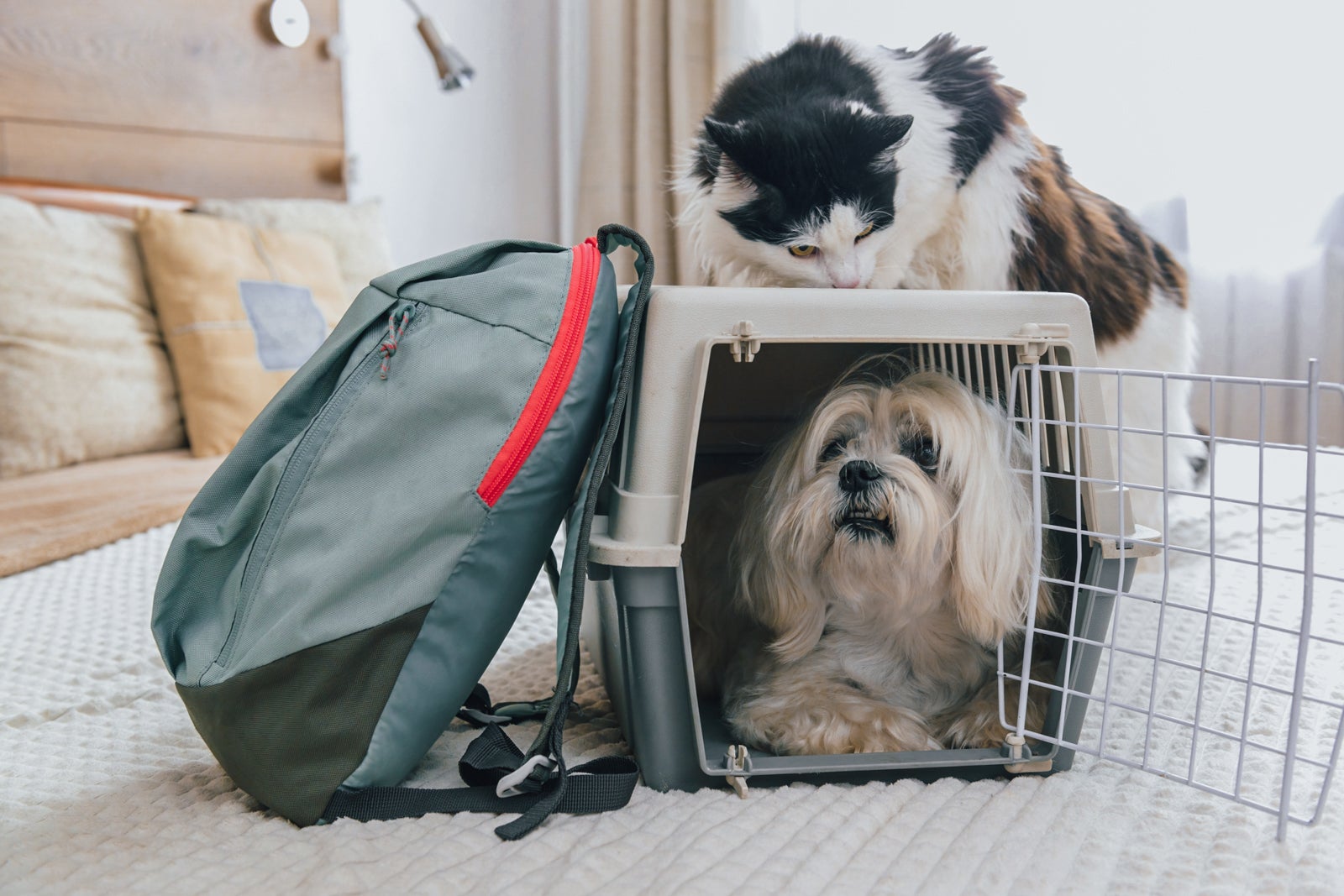
When traveling with a pet, it's important to consider several variables. While all airlines listed below allow small dogs and cats to fly in the cabin, only a select few allow other household pets. Frontier and Spirit offer the most extensive list of animals, including birds, rabbits and several other pet types.
If you're flying internationally, you'll want to consider a different subset of pet-friendly airlines. After all, not all airlines allow pets to fly on all routes outside the United States. Some even exclude certain pets from flying once you leave domestic grounds. Some international airlines may provide better pricing and a wider list of animals that can fly.
You'll also find that airlines have different rules about the type of pet carrier and the size. Some airlines even cap the number of total pets on board — making it important to know the ins and outs when determining the best airlines for pets.
If you are flying with more than one dog, or just need a little more space, United is one of the best carriers to fly. Unlike many airlines that do not allow you to book a second seat for your pet, United allows you to book the seat next to you. You will still be required to pay the $125 pet fee on top of the second seat's cost and keep your dog or cat in the carrier. If you are traveling with two pets on United, you are required to book a second seat.
Pet-friendly airlines
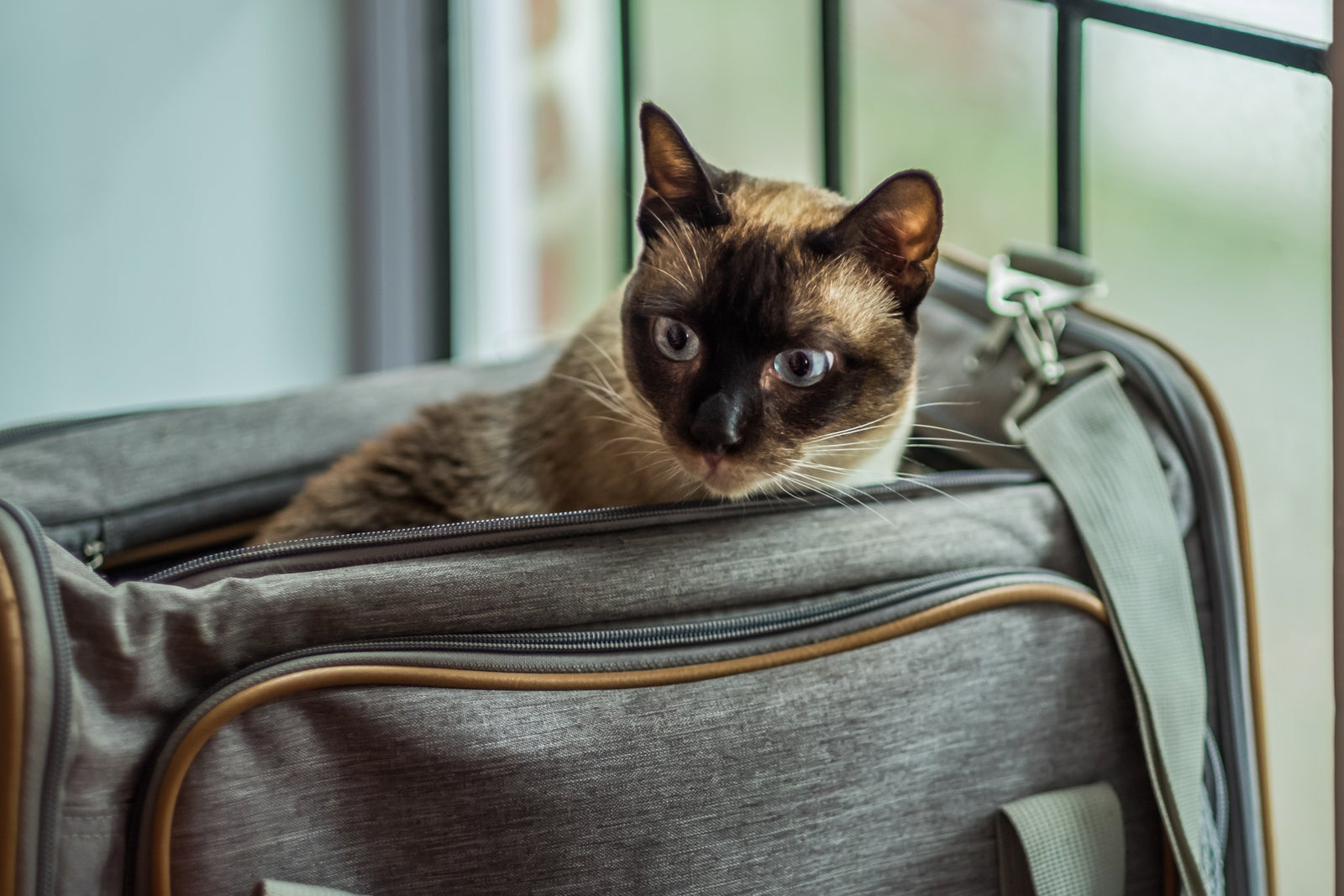
Of the airlines that allow dogs and other pets, the most favorable pricing is with Delta, Frontier and Southwest. Pet-in-cabin fees for domestic flights on these airlines are below $100. For international flights, on the other hand, you'll find Frontier's pricing to be the best, although destinations are more limited.
Many airlines don't allow your pet to fly with you to any international destination, such as Spirit and Southwest. And if you're flying to Hawaii, Southwest, Delta and United aren't options. So before you book your flight and assume your pet can fly with you, you'll want to look at the restrictions for each destination.
Related: The reality of international travel with your dog: How Bandido flew from Vietnam to the US
Airlines that allow dogs
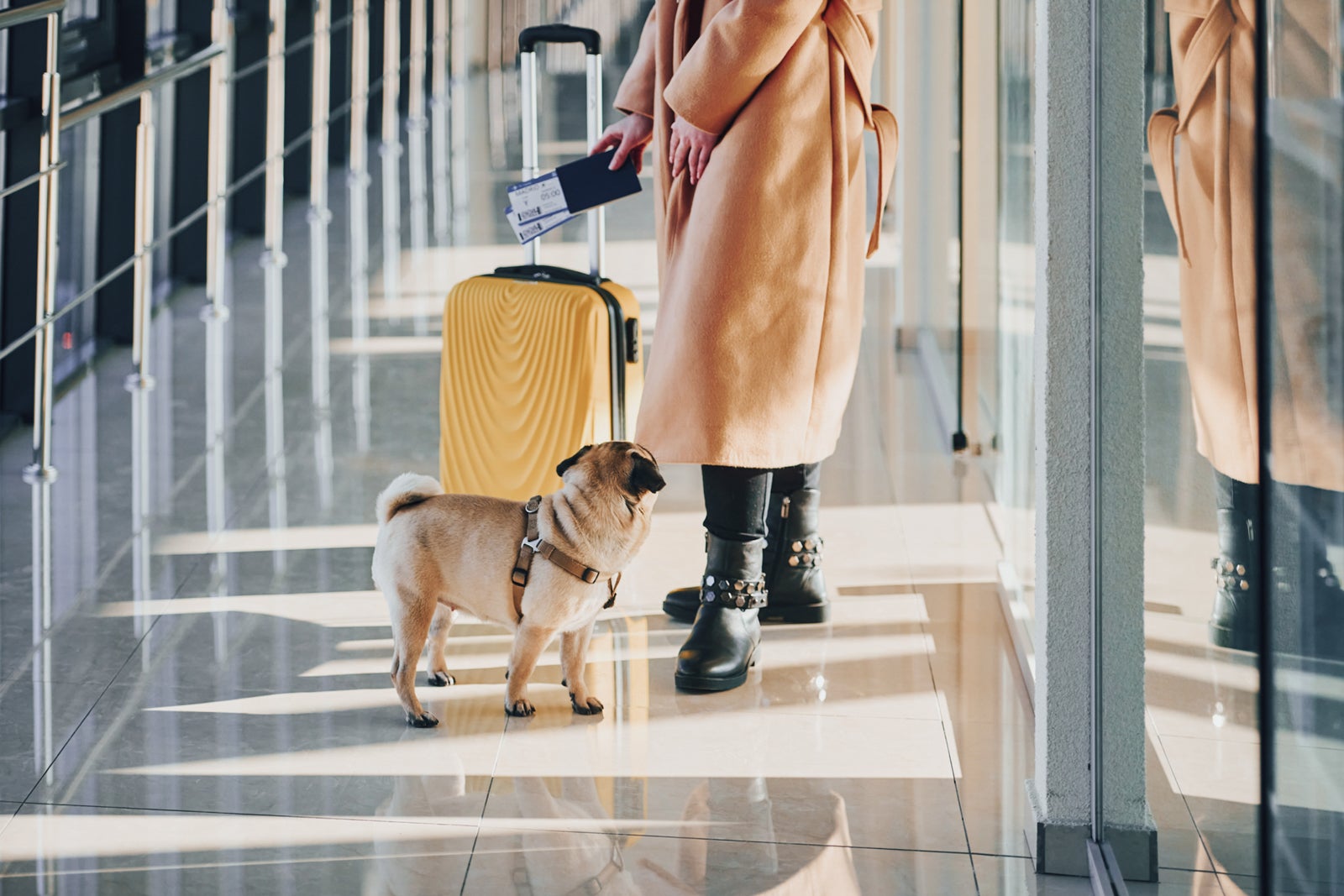
Dogs are one of the most common pets people travel with, so it's no surprise that many travelers are constantly searching for airlines that allow dogs to fly. Fortunately, for any airline that allows pets to travel, dogs are always included in that list. However, most U.S. airlines only allow dogs to fly in the cabin and not underneath the plane in cargo. So you will find it easiest to travel with smaller dogs that can fly in the cabin with you.
Some airlines do allow dogs to fly as cargo in certain situations. For example, American Airlines will allow your dog to fly in cargo if you are a member of the U.S. military on active duty or a U.S. State Department Foreign Service employee traveling on official orders.
Even if you do decide to fly with a dog or dogs, however, airlines differ in price and policies. Look at the above chart to see which is best for your trip.
Related: What you need to know about traveling with dogs on a plane
Tips for keeping your dog happy on the flight
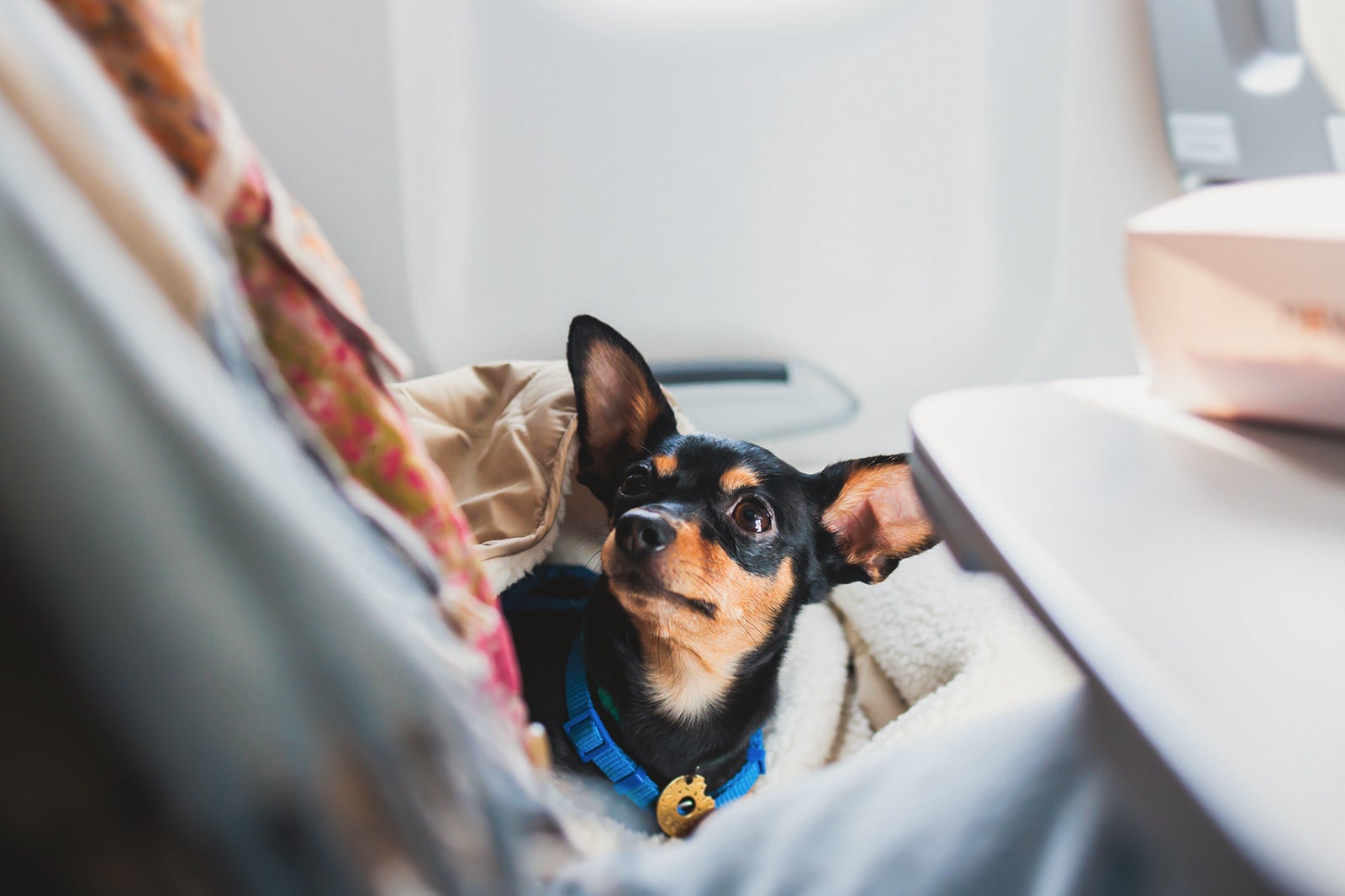
Your dog's first flight can be a nerve-wracking experience. Will he or she fear flying? Bark the whole time in the carrier? Take some of the anxiety out of the situation by making sure your dog is acclimated to the carrier before the trip.
"You'll want to spend some time doing some pre-travel training in the carrier to make sure your dog is accustomed to being in it for the anticipated length of the flight," says Dr. Julie Buzby, an integrative veterinarian and founder of ToeGrips for dogs. "The goal is to teach the dog to think of the carrier as a home base or safe haven, which will greatly decrease travel anxiety."
Buzby says all dogs benefit from this pre-travel crate training, but it is vital for the "smushed nose" dog breeds like Frenchies who are anatomically more prone to developing respiratory distress from stress and anxiety.
She also recommends feeding a smaller meal than normal to decrease the likelihood of an in-flight potty emergency. And, ideally, don't feed your dog less than four hours before flying.
"Although it's hard to resist those puppy dog eyes, your dog will be less likely to get airsick if you don't feed him or her immediately before the flight. This is so the dog's stomach is more empty than full," Buzby says.
And she says to remember the adage that a tired dog is a good dog.
"If I were flying with my dog in any capacity, I'd provide a robust play/exercise session the day before and the morning of travel," Buzby says. "Finally, I would probably carry a peanut-butter-smeared Kong in a Ziploc to use in flight in case of emergency."
Bottom line
With many pet-friendly airlines available — as long as your pet can fit in a carrier and travel in the cabin — it's easy to take your pet with you on your next vacation.
There's no one specific airline that wins the award of "best airline for pets" as it comes down to the type of animal you are bringing and your destination. Fortunately, pricing is within the same general range for all pet-friendly U.S. airlines. So, pick an airline that works for your particular situation and enjoy the flight.
Related reading:
- Key travel tips you need to know — whether you're a beginner or expert traveler
- The best travel credit cards
- Where to go in 2024: The 16 best places to travel
- 6 real-life strategies you can use when your flight is canceled or delayed
- 8 of the best credit cards for general travel purchases
- 13 must-have items the TPG team can't travel without

United Airlines Pet Travel: A Comprehensive Guide
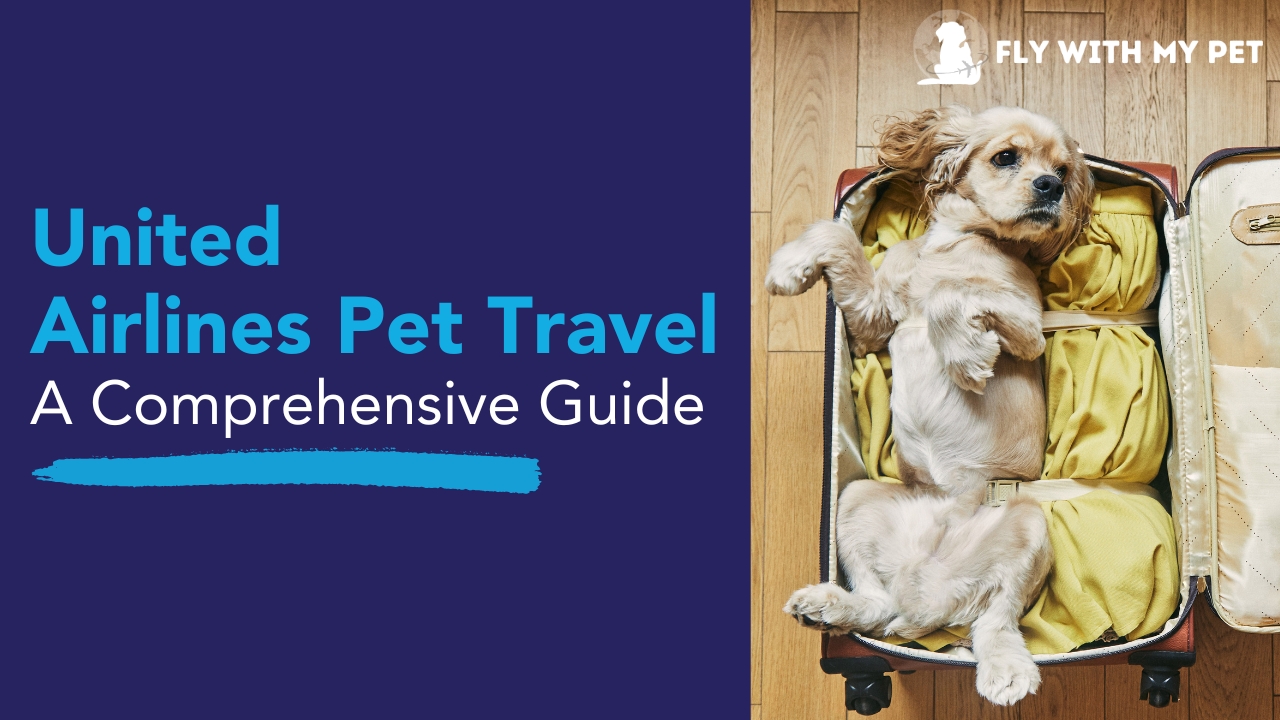

Carry on or transport your pet
Depending on animal breed and size, they can travel as a carry-on or be transported through American Airlines Cargo. Carry-on pets are limited to cats and dogs that meet the size, age and destination requirements.
We only accept checked pets at the ticket counter for active-duty U.S. Military and U.S. State Department Foreign Service personnel traveling on official orders. Fees and restrictions apply.
Fully-trained service dogs may fly in the cabin at no charge if they meet the requirements.
Service animals
Which destinations allow travel with pets?
You can travel with a pet on most flights up to 12 hours or flights to / from select locations:
- Within the 48 contiguous United States
- The U.S. and Canada*
- Puerto Rico
*Additional special restrictions may apply when traveling with pets to / from these destinations.
The U.S. Centers for Disease Control and Prevention (CDC) sets the requirements for bringing dogs into the United States. These rules apply to all dogs, including service dogs, and returning pets. All customers, regardless of citizenship, must follow the CDC’s requirements.
Before you travel
Check the CDC's guidelines for detailed information on bringing dogs into the U.S., including the latest updates.
New requirements take effect on August 1, 2024, and depend on your dog's travel history in the six months prior to arriving to the U.S. Dogs arriving from high-risk countries for rabies have additional requirements.
Read more about bringing a dog into the U.S. Opens another site in a new window that may not meet accessibility guidelines
On your travel day
Bring all required documents and forms to the airport and present them at check-in.
Embargo on dogs from high-risk countries
American does not accept dogs as carry-on pets if they originate from or have visited a high-risk country for rabies in the six months prior to the date of travel. This restriction does not apply to service dogs that meet CDC requirements.
View the CDC’s list of high-risk countries for rabies Opens another site in a new window that may not meet accessibility guidelines
USDA requirements for screwworm
If your dog is coming from a country with screwworm, it must meet specific requirements set by the U.S. Department of Agriculture's Animal and Plant Health Inspection Service (APHIS)
Read USDA APHIS VS requirements Opens another site in a new window that may not meet accessibility guidelines.
The Australian Department of Agriculture and Water Resources does not accept applications to import assistance or service animals of any species other than dogs.
An assistance or service dog which is accredited by an Australian State or Territory Government will also qualify. In most cases these animals are returning to Australia.
Australian requirements for assistance and service dogs Opens another site in a new window that may not meet accessibility guidelines
You’ll be responsible for fulfilling all entry requirements and must notify the department of the dog’s intended arrival at least 3 working days before export.
The Canadian Food Inspection Agency (CFIA) has issued a suspension on the import of commercial dogs from countries at high-risk for dog rabies.
Commercial dogs will not be permitted to enter Canada from the identified high-risk countries.
CFIA notice of suspension Opens another site in a new window that may not meet accessibility guidelines
Carry-on pets
You cannot travel with a carry-on pet when traveling to Jamaica.
Additional restrictions
When traveling with a pet to Trinidad and Tobago (POS), you cannot arrive on a flight before 8 a.m. or after 4 p.m.
Continental U.S.
Within the u.s..
Pets traveling within the U.S. and Puerto Rico must be at least 8 weeks old.
To the U.S.
All dogs (carry-on and checked) traveling to the U.S. must meet government regulations on vaccinations.
Requirements Opens another site in a new window that may not meet accessibility guidelines.
You cannot travel with a carry-on pet when traveling to / from Hawaii.
Checked pets
You can travel with your pet to Hawaii as a checked pet if you:
- Only connect via Honolulu (HNL)*
- Follow Hawaii’s quarantine rules
Animal quarantine rules in Hawaii Opens another site in a new window that may not meet accessibility guidelines.
*No pets are accepted on departures out of Honolulu prior to 8 a.m. HT between March 5 and November 1.
You cannot travel with your pet to Hawaii:
- On nonstop flights to Maui, the Big Island of Hawaii or Kauai
- If your pet is pregnant and past 45 days gestation
All pets traveling to Mexico must meet government regulations on vaccinations.
Government regulations and vaccinations in Mexico Opens another site in a new window that may not meet accessibility guidelines.
South America
You cannot travel with a carry-on pet when traveling to / from:
Transatlantic
You cannot travel with a carry-on pet on transatlantic trips.
When traveling to the European Union (EU) with a checked pet, you’ll be responsible for completing all entry requirements. Your pet must have a tattoo or implanted microchip that matches the ID number on their vaccination card.
Apart from service animals, you can't travel with a checked pet to the U.K. or Ireland, but you can transport dogs and cats to London (LHR) and Manchester (MAN) with American Airlines Cargo.
Transport your pet with American Airlines Cargo Opens another site in a new window that may not meet accessibility guidelines.
Transpacific
You cannot travel with a carry-on pet on transpacific trips.
Japan exceptions
Although you can travel with a checked pet from Japan to Los Angeles (LAX) or Dallas-Fort Worth (DFW), pets are not allowed as checked bags to Japan. According to USDA restrictions, animals should be offered water every 12 hours, so for travel with a checked pet to LAX or DFW, you must book a flight 12 hours or less.
If you’re traveling with a checked pet for travel from Japan, you’ll need to:
- Make sure your pet has a microchip and documents required by the country you are traveling to
- Notify the Japanese Animal Quarantine Service at least 7 days prior to departure to arrange an inspection
Japanese animal quarantine service Opens another site in a new window that may not meet accessibility guidelines.
On flights with American you can bring one pet carrier as a carry-on if:
- You pay the carry-on pet fee
- Your pet stays in the pet carrier and under the seat in front of you the entire flight
You can bring only one additional item on board with your pet:
- A personal item like a purse or small handbag; or
- A carry-on bag that meets requirements and fits in the overhead bin
Carry-on bags
Remember, you can only bring one with your pet carrier, not both.
Pet strollers must be checked at the ticket counter, and all checked bag fees apply.
To add a carry-on pet to your trip, follow these steps:
- Find your trip on aa.com or the American app
- In the Special Services section, select ‘Add carry-on pets’
- Review and agree to the carry-on pet requirements
- Select the flights that you want your pet to travel on
- Confirm your carry-on pet to complete the changes
Find your trip
At the airport, go to the American ticket counter to pay the fee and ensure your pet and kennel meet the requirements.
We assume no liability for the health or well-being of carry-on pets. These rules are enforced:
- Pets must be small enough to fit comfortably inside the closed / zipped carrier.
- Non-collapsible kennels can’t exceed the under-seat dimensions of any aircraft included in your journey. Please contact Reservations to verify maximum dimensions.
- Soft-sided collapsible kennels are recommended and can be slightly larger but still need to fit under the seat without having to excessively collapse the kennel. They must be secure, padded, made of water-repellant material and have nylon mesh ventilation on 3 or more sides.
Carry-on kennel dimensions
Hard-sided kennel.
- Mainline flights on American: 19 x 13 x 9 inches / 48 x 33 x 22 centimeters (length + width + height)
- Regional flights on American Eagle: 16 x 12 x 8 inches / 40 x 30 x 20 centimeters (length + width + height)
Soft-sided kennel (recommended)
18 x 11 x 11 inches / 46 x 28 x 28 centimeters (length + width + height)
Contact Reservations to verify maximum dimensions.
Reservations and ticket changes
Flying in First / Business on an A321T?
- Pets must stay in their kennel during your flight and will need to be placed in a dedicated animal friendly compartment at the front of the plane during taxi, take-off, landing and turbulence
- The combined weight of the carrier and your pet can’t exceed 20 lbs. / 9.07 kgs., weighed at check-in
We can only accept:
- 7 kennels on American flights, excluding service animals
- 5 kennels on American Eagle flights; 1 in First
Due to the lack of underseat storage space, carry-on pets are not permitted in First or Business on:
As recommended by the American Veterinary Medical Association (AVMA), we don’t accept pets that have been sedated or tranquilized. Pets that have been given sedatives or tranquilizers are at a higher risk of respiratory and cardiovascular problems at high altitudes.
If your pet is too large to fly in the cabin, it must travel with American Airlines Cargo. Keep in mind, we only accept checked pets for active-duty U.S. Military and U.S. State Department Foreign Service personnel traveling on official orders, and the pet carrier must meet all kennel guidelines for checked-pets. If you don’t meet these requirements, your pet may not travel. Fees and restrictions apply.
Kennel guidelines for checked pets
We only accept checked pets for active-duty U.S. military and U.S. State Department Foreign Service personnel traveling on official orders. Up to 2 pets may be checked and they must meet the minimum age and health requirements of the destination. Since capacity is limited, we accept checked pets on a first-come basis.
When checking a pet, you need to:
- Contact Reservations at least 48 hours prior to travel
- Check in at the ticket counter with your official orders
- Allow extra check-in time (at least 2 hours and no more than 4 hours before your flight)
- Complete a checklist with an agent
- Provide a health certificate
To ensure the health and safety of your pet, the health certificate you provide must be issued by a vet within:
- 10 days of your travel
- 60 days of your return (travel on the same ticket)
- 10 days of your return (travel on a separate ticket)
All USDA health requirements Opens another site in a new window that may not meet accessibility guidelines.
American PetEmbark®
American Airlines Cargo offers the American PetEmbark ® service for pets that don’t qualify to travel as carry-on or checked pets.
Ship your pet through American PetEmbark ® Opens another site in a new window that may not meet accessibility guidelines.
When checking in your pet, there are specific requirements for their kennel:
- Large enough for your pet to stand, turn, sit and lie down in a natural position (without touching any side or the top of the container)
- Must not exceed maximum size requirements of the aircraft you're traveling on
- Must not exceed maximum weight (combined pet and kennel) of 100 lbs. / 45 kgs.
- Be made of wood, metal, plastic or similar materials
- Have a door made of welded or cast metal
- Secured at the top and bottom with bolts or screws
- Secured by yourself with release cable ties on all 4 corners (we’ll provide complimentary ties)
- Be rigid and secure enough so the animal cannot escape through gaps or poke any body part through the container
- Be leak and escape proof with a secure fastened door
- Have ventilation on at least 3 sides for domestic U.S. travel and 4 sides for international travel
- Have separate food and watering dishes attached securely inside the kennel
- Have a small bag of food for a 24-hour period attached to the top
- Be clean and have absorbent material (no straw, hay or wood shavings)
If you travel with 2 of your pets in the same kennel, they must be:
- The same species (2 cats or 2 dogs)
- A similar size and weigh less than 20 lbs. / 9.07 kgs. each
- Between 8 weeks and 6 months old
Aircraft restrictions and acceptable kennels
Checked pets cannot travel on:
- A321, A321H, A321neo, A321S
Cat restrictions
We don’t accept brachycephalic cats of any 'mix' as checked pets, such as:
- Exotic Shorthair
Cats must be at least 8 weeks old when traveling within the U.S. and Puerto Rico.
Dog restrictions
We don’t accept brachycephalic or snub-nosed dogs of any 'mix' as checked pets, such as:
- Affenpinscher
- American Staffordshire Terrier
- Boston Terrier
- Boxer (all breeds)
- Brussels Griffon
- Bulldog (all breeds)
- Dogue De Bordeaux
- English Toy Spaniel
- Japanese Chin
- Mastiff (all breeds)
- Presa Canario
- Pug (all breeds)
- Staffordshire Bull Terrier
- Tibetan Spaniel
Dogs must be at least 8 weeks old when traveling within the U.S. and Puerto Rico. If you're traveling into the U.S., your dog's age and vaccine requirements depend on the risk of dog rabies where your trip starts. Dogs arriving from high-risk countries need to be at least 16 weeks old and have their rabies shots before traveling into the U.S.
Check if your trip starts in a high-risk country.
Flights with connections
If you’re traveling on a connecting flight, checked pets will only be able to connect through these cities:
- Charlotte, NC (CLT)
- Chicago O'Hare, IL (ORD)
- Dallas / Fort Worth, TX (DFW)
- Los Angeles, CA (LAX)
- New York Kennedy, NY (JFK)
- New York LaGuardia, NY (LGA)
- Miami, FL (MIA)
- Philadelphia, PA (PHL)
- Phoenix, AZ (PHX)
- Washington Reagan, DC (DCA)
Food and water
Due to Federal Regulations, you’ll need to provide written certification that:
- Your pet has been fed and offered water within 4 hours (with the specific time noted) before you deliver them to the airplane
- Is securely and visibly attached to the outside of the kennel
- Has your signature with the date and time you signed it
You’ll also need to provide feeding and watering instructions for a 24-hour period. Unless specified by a vet, you cannot leave instructions saying 'no food or water.'
If you’re flying with American Airlines, you can pay your pet travel fee at the airport or at a travel center with a credit card or paper voucher (where accepted). We don’t accept cash or checks for payment.
We don’t collect pet fees for other operating airlines on your trip (even if it has an American flight number). You’ll need to check in with each airline and pay your fees at check-in. To find out if you're on a partner airline, look for the words, "Operated by" on your ticket.
What's a codeshare?
*Fees shown apply for each destination without a voluntary stopover / connection of 4 hours or more. If your trip includes a voluntary stopover / connection of more than 4 hours, fees apply for each connection segment. All pet fees are non-refundable and apply per kennel, each way. Fees for transporting your pet with American Airlines Cargo may vary depending on the trip details and size of the animal and kennel.
**For tickets issued on / before February 19, 2024, the carry-on pet fee per kennel is $125 and for tickets issued on / after February 20, 2024, the fee is $150.
Flights departing Canada
Find out how much you'll pay for pet and other fees on roundtrip and one-way flights departing Canada, displayed in CAD.
Pet and other fees - Canada
Temperature restrictions
We have temperature restrictions to make sure checked pets and pets traveling with American Airlines Cargo aren’t exposed to extreme heat or cold:
- In the animal holding areas
- At terminal facilities
- When moving the animals between terminal and the plane
- On a plane awaiting departure
You cannot travel with a pet if the current or forecasted temperature is above 85 degrees Fahrenheit (29.4 degrees C) at any location on the itinerary.
Pets not traveling in cabin cannot travel to / through / from Phoenix (PHX), Tucson (TUS), Las Vegas (LAS) or Palm Springs (PSP) May 1 – September 30.
You cannot travel with a pet if the ground temperature is below 45 degrees Fahrenheit (7.2 degrees C) at any location on the itinerary.
We may waive the cold temperature restrictions if you have a written letter from a licensed vet that includes:
- Your name and address
- Your pet’s name
- Your vet’s name and signature
- Your vet’s accreditation date and number
- The temperature your pet is acclimated to
The letter must be dated:
- Within 10 days of the first flight your pet will be on
- Within 30 days of any other trips in the same itinerary
You may need an additional letter for lengthy trips. If the temperature is below 20 degrees Fahrenheit (-6.6 degrees C), your pet cannot be checked even with a letter from your vet.
Flying on a partner airline?
Find helpful information if your trip includes 1 or more flights with our partner airlines.
- British Airways
- Japan Airlines
- Qatar Airways
Flying With Pets On American Airlines: What You Need To Know
- November 4, 2024
- Lauren Stuttaford
Flying with your pet soon? Let’s make it as easy — and enjoyable — as possible for both of you! Flying with pets on American airlines can be super simple – we’ll show you how! Whether you’re jetting off with your furry friend for the first time or looking for the latest on airline pet policies, we’ve got you covered.
In this guide, we’ll break down the essentials: booking your pet’s ticket, understanding airline fees, choosing the right carrier size, and preparing for a smooth flight. Plus, we’ve sprinkled in some practical advice to keep your pet comfortable and calm at 30,000 feet.
Before we get started, just a heads-up: policies can change, so it’s always best to double-check with each airline’s website for the latest info.
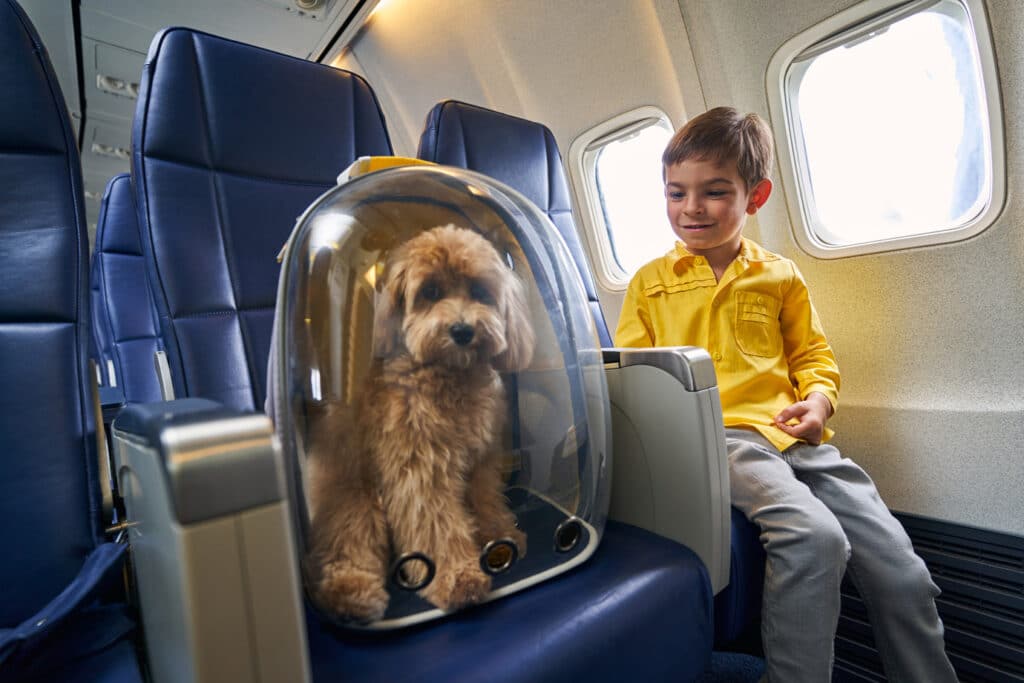
A Quick Breakdown Of Airlines
Each airline has specific policies to ensure a safe and comfortable journey for pets, so let’s dive into the details. Here’s a breakdown of the pet travel rules for the most popular U.S. airlines.
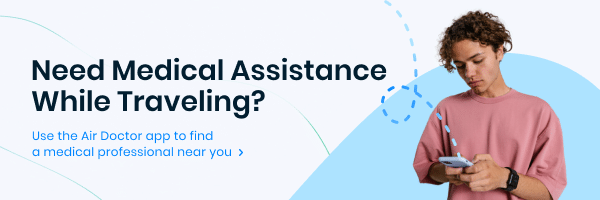
American Airlines
American Airlines allows small dogs and cats to travel in the cabin on most domestic and some international flights.
- Size Requirements : Pets (combined with their carrier) must weigh no more than 20 pounds. Carriers should measure up to 19” x 13” x 9” for soft-sided and hard-sided carriers.
- Cost : $125 per pet, per segment.
- Checked Luggage : American Airlines does not allow pets as checked luggage. However, larger pets can travel via their separate cargo service on select routes.
- Other Notes : Some international routes and locations, such as Hawaii, have restrictions. Always check American Airlines’ Pet Policy Page for updates.
Southwest Airlines permits small cats and dogs to fly in the cabin on domestic flights only.
- Size Requirements : Pets must fit comfortably in carriers no larger than 18.5” x 8.5” x 13.5”.
- Cost : $95 per pet, per segment.
- Checked Luggage : Pets are only allowed in-cabin; Southwest does not accept pets as checked luggage or cargo.
- Other Notes : There’s a limit of six pets allowed on each flight, so booking early is recommended. For full guidelines, visit Southwest’s Pet Policy Page .
Delta Airlines
Delta allows small dogs, cats, and household birds (domestically) to travel in-cabin with their owners.
- Size Requirements : Pets must fit comfortably in carriers up to 18” x 11” x 11”.
- Cost : $125 for domestic flights; fees vary for international travel.
- Checked Luggage : Delta does not allow pets as checked luggage but offers Delta Cargo as an option for pets that are too large for the cabin.
- Other Notes : Some routes have additional restrictions, so it’s important to check Delta’s Pet Policy Page before booking.
United Airlines
United Airlines permits small cats and dogs to fly in the cabin on many domestic and select international flights.
- Size Requirements : Pets should fit comfortably in carriers that measure up to 18” x 11” x 11”.
- Cost : $125 per pet, per segment; an additional fee applies for layovers longer than four hours domestically or 24 hours internationally.
- Checked Luggage : Pets cannot fly as checked luggage; United offers the PetSafe program, a cargo option for larger pets.
- Other Notes : United has specific requirements and routes for PetSafe, so it’s best to consult United’s Pet Policy Page for detailed information.
JetBlue allows small dogs and cats to accompany passengers in the cabin.
- Size Requirements : Pet and carrier combined must not exceed 20 pounds, and the carrier should be no larger than 17” x 12.5” x 8.5”.
- Cost : $125 per pet, per flight.
- Checked Luggage : JetBlue only allows pets in-cabin and does not offer checked luggage or cargo options for pets.
- Other Notes : JetBlue’s JetPaws program offers pet owners perks like a carrier bag tag and pet travel guide. Learn more on their Pet Policy Page .
Spirit Airlines
Spirit Airlines permits small pets, including dogs, cats, small birds, and rabbits, to travel in-cabin on most domestic flights.
- Size Requirements : Pet carriers must fit under the seat, with maximum dimensions of 18” x 14” x 9”.
- Cost : $110 per pet, per flight segment.
- Checked Luggage : Spirit only allows pets in the cabin and does not accept pets as checked luggage or cargo.
- Other Notes : A maximum of four pets is allowed per cabin on each flight, so early booking is advised. Visit Spirit’s Pet Policy Page for more information.
Preparing Your Pet for Air Travel
Flying with pets on American airlines might be stressful for you – but it’s even more stressful for your pets. That’s why it’s essential to help them get comfortable with the process beforehand.
Here’s how to prep your pet for air travel.
Familiarize Your Pet with Their Carrier
First off, you need to make sure your pet’s comfortable with their carrier.
- Start Early : Set up your pet’s carrier in a familiar area at home weeks before the trip. Leave the door open, add a comfy blanket, and encourage them to explore and rest in it.
- Positive Reinforcement : Give treats, toys, or praise when your pet goes into the carrier. This teaches them that going into the carrier isn’t a bad thing.
- Short Practice Trips : T your pet on short car trips in their carrier to mimic the travel experience. This helps them adjust to being in the carrier for longer periods.
Vet Check-Up and Required Documents
Next, you need to make sure your pet’s papers (and their health) are good to go.
- Health Certificate : Some airlines need health certificates from a vet. This is especially important for pets traveling in cargo or on international flights. It’s usually issued within 10 days of traveling.
- Vaccinations : Make sure your pet is up-to-date on vaccinations and any other medical clearances required by the airline or destination country.
- Microchip & Identification : If your pet isn’t microchipped already, you should consider doing so. You should also make sure they have an ID tag with your contact information.
Exercise and Routine Before the Flight
Another way to get your pet comfortable is to wear off some excess energy and cut down their food and water intake.
- Exercise : A bit of exercise on the day of travel can help burn off excess energy, making it easier for your pet to rest during the flight.
- Limit Food and Water Intake : Try not to feed your pet a big meal right before flying, as the motion might upset their stomach. Offer small amounts of water to keep them hydrated but avoid overfilling their water bowl.
Packing Essentials for Your Pet’s Comfort
Here are some essentials for your pet’s flight.
- Favorite Toy or Blanket : Bring a favorite toy or blanket that smells like home to help them feel secure.
- Portable Water and Food Dishes : Collapsible or spill-proof bowls are great for travel. If your pet is prone to anxiety, you may also consider treats designed for calming.
- Waste Bags and Pads : Bring waste bags and consider a disposable pee pad for the carrier if your pet is traveling in-cabin.
Calming Your Pet During Security Screening
The security screening process may be a bit scary for your pet. Here’s how you can avoid it.
- Practice Security Checks : Most airport security requires pets to be taken out of their carriers during screening. Practice this process at home so your pet becomes accustomed to being gently removed and then returned to their carrier.
- Leash and Control : Have a leash on hand in case your pet gets nervous or restless during the security check.
Consider a Trial Run at the Airport (If Possible)
Some airports offer pet-friendly spaces or areas where pets can stretch out and take breaks. If you can, take a quick trip to the airport before the flight day to let your pet become familiar with the sights, sounds, and smells of the airport environment.
Carrier Requirements
When it comes to pet travel, having the right carrier is essential for a smooth experience. Airlines have specific requirements to ensure your pet’s comfort and safety, as well as to make sure the carrier fits under the seat in front of you. Here’s what to keep in mind:
1. Know the Size Requirements
Most airlines require that in-cabin carriers fit comfortably under the seat. Typically, this means the carrier should measure around 18” x 11” x 11” (though exact dimensions vary by airline). Double-check the specific requirements for your airline to avoid any issues at check-in.
2. Choose the Right Type of Carrier
Soft-Sided vs. Hard-Sided : Soft-sided carriers are more flexible and can be gently compressed under the seat, which can be helpful on flights with strict size requirements. Hard-sided carriers are sturdier but usually have less flexibility. Ventilation: Look for carriers with ample ventilation on at least two sides, so your pet can breathe easily and stay cool. Mesh panels are ideal for keeping the airflow steady.
3. Comfort Is Key
Make sure the carrier has a soft, cozy bottom—many come with fleece padding or you can add a small pet blanket to help your pet feel more secure. Pets should be able to stand up, turn around, and lie down comfortably inside.
4. Security and Accessibility
The carrier should have secure zippers or latches to keep your pet safe inside but also allow easy access for you to give them a treat or some comfort during the journey. Some carriers even have small “peek windows” so you can reassure your pet without opening the main zipper!
5. Know the Weight Limit
Many airlines have a combined weight limit for pets and carriers, often around 20 pounds. Check your airline’s guidelines to make sure your pet’s weight meets the requirements for in-cabin travel.
6. Label It!
Attach a small tag with your pet’s name, your contact information, and any travel-specific info (like flight numbers) to the carrier. This little detail can be helpful for airline staff and adds an extra layer of safety.
Buying Tickets For Your Pet
Booking a ticket for your furry friend is easier than you might think! Here’s a quick guide to make sure you’re ready to take your pets flying on American airlines:
Airlines only allow a certain number of pets per flight, so it’s a good idea to reserve your spot as soon as you know your travel plans. During busy seasons, these spots fill up fast!
Reach Out To The Airline
Many airlines prefer you to book your pet’s ticket over the phone, so give their customer service line a call. Some airlines may allow you to add a pet ticket online, but a quick chat with the airline team can make sure all your pet’s needs are covered.
Double-Check The Details
Be clear about whether your pet will fly in the cabin with you or in the cargo area. Airlines have specific guidelines based on your pet’s size, breed, and even the length of the flight. Make sure your pet’s carrier fits the airline’s size guidelines. Some airlines are specific about soft-sided versus hard-sided carriers, so it’s good to have the right measurements handy.
Bring The Necessary Documents
Many airlines require a recent health certificate from your vet, especially for longer flights or international trips. This shows your pet is in good health and ready to fly! It’s also helpful to have proof of vaccinations with you, just in case.
Get Ready For Check-In Day
Give yourself a bit of extra time at the airport in case there are any additional steps for pet check-in. Make sure you have your pet’s carrier, travel documents, and some comforting items to keep them relaxed. You’ll both feel more prepared and ready to go.
Download The Air Doctor App
With the Air Doctor app in your pocket, you can access medical advice, get prescriptions, and receive expert medical guidance wherever you are in the world!
Air Doctor’s easy-to-use app gives you:
- A global network of over 20,000 multi-lingual doctors and specialists
- Choice of clinic, at-home (hotel), and video consultations
- Active in 78 countries
- Video consultation services and valid, local prescriptions in up to 21 languages + 84 countries
- 24/7 multi-lingual support
- Transparent pricing, and reviews
- Most common medical specialties
- So much more

Flying With Pets On European Airlines: What You Need To Know
Flying with pets on European airlines? We’ve got you covered! In this blog, we look at everything you need to...

Flying with pets on American airlines? We’ve got you covered! In this blog, we look at everything you need to...

72 Traditional Christmas Foods from Around the World for Traveling Foodies
From unique traditions to festive spices, here are 40 Christmas foods from around the world that every traveling foodie should...

The Best Beaches Around Lisbon, Portugal
Looking for the best beaches around Lisbon? We’ve got you covered! Take a look at the top beaches in Lisbon,...

Top 15 Budget Travel Destinations You Haven’t Considered Yet
Want to get the most value from your next vacation? Here are a few destinations you might want to consider...

The Ultimate Budget-Friendly Travel Guide
Looking for the ultimate budget-friendly travel guide? You’ve found the right place! We’ve got everything you need to know, including...

How to Handle the Current Heatwave in Europe for 2025
Don’t let heatwaves ruin your travel in Europe. Here are the best tips to protect yourself from the heatwaves in...

Traveling to Florence Italy (+ 3-day Itinerary)
Traveling to Florence, Italy? 3-day itinerary for Florence listed here including where to stay, what to eat, what to do...

How To Travel Japan On A Budget
Looking to visit the land of the rising sun without breaking the bank? We’ve got you covered. Here’s everything you...

Jenny Cohen Derfler
Air dr ceo & co-founder.
Jenny is the CEO and one of the Co-Founders at Air Doctor. She spent more than 20 years at Intel, most recently as general manager of its manufacturing facility in Israel and before that in various engineering and manufacturing roles in Silicon Valley. Air Doctor is her second startup having previously founded electric vehicle company ElectRoad.

Unfortunately Greenback is not compatible with older versions of internet explorer (less to IE 9). Please log in with an updated version of Internet Explorer, Firefox, Opera, Safari or Google Chorme
Blog Tax Tips For Expats
Navigating International Moves with Your Pet: A Step-by-Step Guide

- 6.6K shares
Relocating abroad is an exciting adventure, but it comes with challenges—especially when you’re moving with a beloved pet. From paperwork to vaccinations, it can be overwhelming. This guide will simplify the process, providing essential information to help you and your furry friend make a smooth international transition.
Research Pet Import Regulations Early
The first step in moving internationally with a pet is to research the import regulations of your destination country. Each country has its own set of rules regarding pets, which can vary significantly. For example, countries like Australia and New Zealand are known for their strict biosecurity laws, requiring detailed documentation, mandatory microchipping, and a series of health checks. Some destinations, like the United Kingdom , require pets to be treated for tapeworms before arrival, while countries within the European Union may allow pets with an updated pet passport to enter smoothly.
Start your research as soon as you know you’ll be moving, as requirements like rabies vaccinations or blood titer tests may take months to complete. Consulting your veterinarian early on can help ensure your pet meets all health requirements without delay.
Getting the Right Paperwork in Order
Moving internationally with a pet involves a fair amount of paperwork. Depending on your destination, you may need an International Health Certificate (IHC) from a certified veterinarian, export permits, and proof of vaccinations. For example, if you’re moving to Japan , the process can take six months from the rabies vaccination until your pet is cleared for travel. Ensuring your pet has the appropriate ISO-compliant microchip is another crucial step—some countries, like South Africa , require this specific type of microchip to scan at customs.
Consult a USDA-accredited veterinarian for the necessary health certifications. In some cases, the IHC must be endorsed by the US Department of Agriculture (USDA) itself. If your destination requires an apostille (a form of authentication for international documents), getting it can take additional time, so plan accordingly.
Choosing the Right Airline and Pet Carrier
Choosing a pet-friendly airline .
Air travel can be stressful for pets, so it’s crucial to choose a pet-friendly airline. Many international airlines, such as Lufthansa and KLM , offer specialized pet services that prioritize safety and comfort. Lufthansa, for instance, has a dedicated pet lounge in Frankfurt Airport , making it easier for pets to rest during layovers.
Ensuring Your Pet Carrier Meets Requirements
Make sure your pet carrier meets International Air Transport Association (IATA) requirements —this typically includes adequate ventilation, secure locks, and enough space for your pet to move comfortably. Some airlines will require pets to travel in the cargo hold, while others, like Delta and United , may allow small pets in the cabin if they meet weight and size limits. Verify the airline’s pet policies well ahead of time, especially considering layovers and connections, to ensure a smooth journey for your furry friend.
Consider Quarantine Requirements
Certain countries have quarantine requirements for pets, depending on where you’re arriving from. For example, Singapore requires pets from high-risk rabies countries to quarantine for at least 10 days, while Australia can require a quarantine of up to 30 days. Quarantine is a measure to ensure that no infectious diseases are brought into the country, but it’s important to prepare emotionally and financially for this period if applicable.
One way to ease your pet’s experience is to familiarize yourself with the quarantine facility. Many locations, such as Mickleham Quarantine Facility in Melbourne, allow pet owners to visit and check on their pets during the quarantine period, which can be comforting for both owners and pets.
Preparing for the Move Day
On the day of travel, make sure your pet has everything they need for a comfortable journey—food, a favorite toy, and absorbent pads for accidents. Sedating pets for air travel is usually not recommended, but natural calming aids like pheromone sprays can help to alleviate anxiety.
Consider arranging pet transport services if you’re juggling multiple moving tasks. Companies like PetRelocation or Air Animal specialize in helping pets travel internationally and can manage the complex logistics of travel, documentation, and customs clearance.
Settling In at Your New Home
Upon arrival, let your pet adjust to the new environment gradually. Unpack their familiar toys and bedding first to give them a sense of familiarity. Different countries have different registration requirements for pets. For instance, in Germany , pets need to be registered with the local tax office , while in Singapore , you’ll need to register your pet with the Agri-Food and Veterinary Authority (AVA) .
Routine veterinary care is also crucial during this period. Find a local veterinarian to schedule a check-up soon after arrival, ensuring your pet has adjusted well and that any minor health issues are addressed.
Pet Travel Stories: Learning from Other Expats
Hearing others’ experiences can be immensely helpful. Take the story of Laura , an expat who moved from the US to Switzerland with her golden retriever, Max . She found that starting the paperwork early and choosing a pet-friendly airline made all the difference in reducing stress during the transition. On the other hand, Mike , who moved to Hong Kong with his cat, emphasized the importance of choosing the right pet carrier—his cat’s anxiety significantly reduced when he upgraded to a larger, more comfortable model.
These real-life accounts highlight that, while the logistics may seem complex, a successful move is entirely possible with thorough preparation.
Final Thoughts: Plan, Prepare, and Enjoy the Journey
An international move with your pet takes some extra planning, but the reward of having your furry companion by your side in your new adventure is well worth the effort. By starting early, keeping track of necessary documents, and preparing for any hurdles like quarantine or health checks, you can ensure a safe and comfortable journey for your beloved pet.
Need Help with Moving or Tax Matters?
Moving abroad can involve more than just logistics; it often brings with it various tax implications. Greenback expat tax services are here to help you manage those financial complexities so you can focus on what truly matters—making your new place feel like home for you and your pet.
Contact us , and one of our customer champions will gladly help. If you need very specific advice on your specific tax situation, you can also click below to get a consultation with one of our expat tax experts.

Free Guide As an American living abroad, knowing what deductions and credits you’re eligible for could save you big time.
- Hidden First Name
- Hidden Last Name
- Email Address *
- Hidden Country
- Hidden Tax Guide Submission Choose One Guide for Americans in France US Tax Deadlines + Extensions Tax Fairness Act Buying + Selling Real Estate Abroad 12 Things Behind on Taxes Document Checklist Guide Guide for Americans in UK New Tax Bill Guide 25 Things to Know Newsletter Sign Up Deductions and Credits Reference
- Hidden Webinar Submission Choose One France Refunds 2019 7 Ways Greenback Takes Stress Out 2019 Top 5 Tax Law Changes 2019 Streamlined Filing 2018 Expat Tax Fact Check 2018 Top Questions + New Tax Bill 2018
- Hidden Country Submission Choose One UK Australia Germany France Switzerland Sweden China Canada New Zealand Singapore Japan
- Hidden Audience Submission Choose One Late/Streamlined Filers Americans Working Abroad Military Contractors Small Business Owners Freelancers and Entrepreneurs Planning a Move Abroad Digital Nomads Accidental Americans Dual Citizens Foreign Property Owner International teachers Back in US
- By entering your email, you agree to receive emails from Greenback. You may opt out at any time per our Privacy Policy .
- Hidden userType
- Hidden FormType
- Hidden Monetary Value
- Name This field is for validation purposes and should be left unchanged.
" alt="B&T"> -->
Home » News » Travel Weekly take: Was Rex failure the result of a market duopoly or internal politics?
Travel Weekly take: Was Rex failure the result of a market duopoly or internal politics?

Ever since Rex went into administration on Tuesday evening, everybody and their dog has been asking the same question – ‘what went wrong?’
Unlike failed airline Bonza which only commenced operations in January 2023, Rex was a staple of the Australian aviation industry with roots reaching back to 1953 (when Hazelton Airlines was set up).
With two Australian airlines going down this year already (and we’re only in August) others have started to speculate that the issue is not with the airlines but rather with the aviation industry itself.

Does the aviation industry need reform?
On Friday, the Australian Travel Industry Association (ATIA) , called for a reform of the aviation industry, expressing support for the comments of former ACCC Commissioner Rod Sims.
It supported its argument with a stack of data highlighting that flights have been cancelled for commercial gain, which much of the cost of this falling to travel intermediaries.
Meanwhile slot hoarding – the practice of airlines buying slots they don’t use to hurt competition – has also come under the spotlight.
Labor has vowed to come down hard on anti-competitive behaviour so that it is easier for new airlines to have access to Australia’s top airports.
On Monday, Transport Minister Catherine King opened a competitive tender process to appoint a new manager of Sydney Airport’s lucrative timeslots, following recommendations from the Harris Review and the ACCC.
For those who missed it, the Albanese Government is reforming slots at Sydney Airport. We are doing what the Coalition failed to do. We have been consulting since announcing changes in February and will be bringing legislation to parliament. — Catherine King MP (@CatherineKingMP) July 31, 2024
Are macro issues to blame?
Aside from political issues, others have said that macro issues make it difficult to run an airline in Australia.
Following the collapse of budget airline Bonza, Qantas CEO Vanessa Hudson has said the aviation market in Australia is not set up to sustain more than three airlines.
Speaking at the launch of the airline’s new 17-hour flight from Perth to Paris, Hudson said the Australian aviation industry was different from other Western markets because of its low population and reliance on domestic travel.
“If you think about why three airlines really struggle, it’s a number of things – our population; the US has 250 million people, we have 26 million and spread between the economics of being a viable airline, it’s incredibly challenging because it’s capital intensive,” Hudson told Nine Newspapers.
“We are an island nation, our economy relies on domestic aviation and the role that we play as a national carrier. We want our airlines, and Virgin and Rex, we want them to be sustainable, and to be sustainable they’ve got to be making a certain amount of revenue to invest. We don’t want a weak aviation market,” she said.

Vanessa Hudson
Were the problems closer to home?
Still, despite a number of calls for change at an industry level it is impossible to ignore Rex’s own managerial issues.
The first red flag that all was not well at the airport came in early July when Singaporean businessman Lim Kim Hai pushed to get rid of the airline’s entire board just a month after being voted out of his role as executive chairman.
The only director Lim didn’t ask to be removed was the nominee of PAG Asia Capital – a private equity firm that has invested $150 million in the airline.
As highlighted by ABC’s chief business correspondent Ian Verrender, Lim Kim Hai’s previous position as both executive chairman (a position he held for 21 years) and CEO of Rex put the company at a disadvantage as it led to a breakdown in the reporting line. This also made the company unattractive to investors.

Lim Kim Hai
When you dig down further into the weeds, it becomes clear that a lack of slots was not actually an issue that Rex faced.
As reported by The Weekly Time , statistics on slot access at Sydney Airport showed that Rex had as many if not more slots at Sydney Airport than Virgin. Its share of peak versus off-peak slots was 60 per cent peak and 40 per cent off-peak.
Qantas’s peak versus off-peak split was 57 per cent to 43 per cent, while Jetstar’s slots were split 50-50 between peak and off-peak.
There was also a lack of efficiency when it came to Rex’s jets itself. Analysts have estimated that any buyer of Rex will need to invest around $300 million in capital expenditure to renew its ageing fleet of Saab-340s.
A lack of parts following Covid-19 has meant that 25 of Rex’s 57 Saab-340s are grounded across the country’s airports.
One of the most profitable routes in the world
Despite speculation about the profitability the Australian airline industry, Sydney to Melbourne is actually considered to be one of the most lucrative routes in the world.
In the first half of 2023, the route generated revenue of $US1.21 billion ($1.9 billion), more than that made between New York’s John F. Kennedy airport and London’s Heathrow.
Whilst Rex did eventually move into the intercity routes in 2020, this was largely done opportunistically in response to Virgin going into administration.

Rex invested considerable capital in leasing nine Boeing 737 jets and taking up intercity slots but faced headwinds as consumers were still nervous about flying in 2020.
Its attempt to grow its market share by cutting prices for popular roots has also been slammed by analysts who say it created a ‘race to the bottom’ and was unsustainable.
Rex’s expansion into the Golden Triangle – Brisbane, Melbourne and Sydney – also wasn’t publicised very well.
Just a couple of weeks ago the airline launched a bizarre advertising campaign called ‘An Airfare to Remember’ in reference to the 1957 movie, An Affair to Remember , starring Cary Grant and Deborah Kerr.
Much of the market – including Gen Z and Millenial travellers would have been unaware of the film.
New ad agency pitches 60-year-old movie in Rex digital campaign
A lack of diversity in leadership
The airline has also been accused of being out of touch with a leadership team that lacks diversity.
At a board level, all six board members are men. All 10 of the senior managers named on its website are also men.
The lack of diversity comes at a time when other airlines are increasingly improving the number of women in top roles. For example, the CEO of Virgin, Jayne Hrdlicka, and Qantas, Vanessa Hudson, are women.

Despite a diverse workforce, Rex’s senior leadership was dominated by men.
Travel Weekly take: Whilst there is no doubt that the airline industry is facing considerable headwinds at a macro level – including the rise in fuel costs – it is unfair to put the failure of Rex solely at the door of the airline industry as a whole.
On a number of occasions, it failed to adapt to a changing market and arguably was too slow with its diversification into intercity and more profitable routes.
Email the Travel Weekly team at [email protected]
Latest news.

Black Friday deals wrap up
We are sure there are plenty of ways to spend your Black Friday budget, and a cruise is looking like one.
TravelManagers explore luxury trends at Signature Travel Network Global Conference
Representatives from TravelManagers Australia have concluded four days of collaboration, learning and networking with luxury travel brands at Signature Travel Network’s 2024 Annual Conference, which took place in Las Vegas. The annual event, which brings together members of Signature’s luxury travel advisor network, partners, travel media and experts, centred this year on “Leveraging the Signature […]
Refurbed Adelaide Qantas Club opens doors to upgraded features
Qantas opened the doors to its upgraded Adelaide Qantas Club today, just in time for the busy holiday period to provide customers travelling through the city of churches with an improved experience. The contemporary space has been designed to celebrate the beauty of the South Australian landscape and features customised furniture by local designers Agostino […]
Booking.com reports 900% increase in travel scams
Eek. Starting to have alarm bells ring off in our heads over that $250 round-trip we just booked to 'Barli'.
- Cruise Lines
PONANT opens Kimberley 2026 season with early-bird savings
PONANT has officially launched its 2026 Kimberley season, with travellers able to choose from 16 departures aboard luxury small expedition vessels Le Soléal or Le Jacques Cartier, with up to 30 per cent savings for early-bird bookings. Guests will experience spectacular waterfalls, ancient First Nation rock art and cultures, breathtaking whale-watching, and thrilling mangrove Zodiac […]
Flight Centre shares rally following AGM
If you really want to know how the travel sector is doing, the stock market is a good barometer.
Tour Guides Australia ramps up training for new additions to jobs shortage List
If you are offered a guided tour, it's usually a bonus knowing the guide knows what they are talking about.
Qantas Engineering looks to invest in local labor while reversing offshore maintenance
As long as our plane is fixed and maintained BEFORE we fly, is our greatest concern.
- Destinations
REVIEW: A day at Disneyland Resort in California – our magical adventure
When it comes to theme parks, Disneyland takes top spot, even if we did campaign heavily for Sydney's Luna Park.
Envoyage hosts 50 advisors in the Maldives for Icons 2024
We think that this is a really important event and that Travel Weekly journos need to be on the ground to cover it.
Ovation of the Seas hosts Jamie Oliver at inaugural Australian Food Hero Awards
Can this man do no wrong? Except those 30-minute meals which usually take us an hour-plus.
Sustainable Aviation Fuel and carbon footprint reduction key focus at Association of Asia Pacific Airlines conference
This much aviation speak may put many to sleep, but for us, it has us reaching for the popcorn.
- Tour Operators
Tauck announces slew of new itineraries at a private lunch in Sydney
A family business that has been around for 100 years is a hard thing to come by in travel these days!
- Travel Agents
WATCH: Travel Weekly gets a behind-the-scenes look at The Room Residence ahead of tomorrow’s opening
Avid user of the Room-Res platform? Next time you're in Sydney you'd be mad if you don't stop in and say Gday.
Luxury Travel Collection breaks new ground with Affiliate Membership
Accessing the best of the best in luxury travel seems to be quite an attractive proposition.
Beverly Hills hosts Rodeo Drive holiday lighting celebration
We hope the bright lights will detract from the high price tags of shiny goods along this famous shopping drive.
- Food & Beverage
Luxury Escapes announces new Signature Series foodie tour across Malaysia
The elastic-waisted pants will be packed for this particular trip. Or buy a pair there.
ETC Cluster: Great Journeys New Zealand & TruTravels
Agents are invited to join Evolution Travel Collective for their next cluster update with the latest news from Great Journeys New Zealand & TruTravels. Michelle Daniels introduces the new Great Journeys New Zealand Scenic Plus product as well as a range of new tours & packages available on the beautiful railways of New Zealand. With […]
Hockey Australia extends partnership with SportsLink Travel
We think that it is really great that SportsLink Travel is choosing to 'stick' with Hockey Australia.
The Great Ocean Road Coast and Parks Authority encourages travellers to make advanced plans for a safer and enjoyable summer
You also need to be aware of rubber-neckers paying attention to the views, not the road ahead.
Hotel and hospitality venues reminded to help keep schoolies safe
Dodgy IDs aside, where there is a will there is usually a way with teens.
Spectacular Philippines Christmas festival returns to Darling Harbour
Beware giving the littlies a whole serving of halo halo, that purple haze will hit them eventually.
Celestyal “doubles down” with new fare structure, digital wallet and adding 47 cabins to Discovery
With strong Aussie bookings and our preference for back-to-back cruises, expect a big local push from Celestyal.
CLIA shares new 2023 Global Cruise Industry Economic Impact Study
Cruise Lines International Association (CLIA) has shared the highlights from the association’s new 2023 Global Economic Impact Study at the annual CLIA Cruise Forward conference. The study revealed the highest-ever global economic impact from cruise tourism and reaffirmed that 2023 surpassed 2019 as the benchmark year for cruise industry performance. It also confirmed the cruise […]
Air Tahiti Nui announces new and exclusive flight deals
There are plenty of Easter getaway opportunities available with this round of offers.
- Road & Rail
London Transport Commissioner takes an insider look at Sydney Metro
London’s Commissioner of Transport, Andy Lord, has toured the new Sydney Metro yesterday, hosted by the Tourism & Transport Forum. “We’re beyond delighted to welcome Commissioner Andy Lord to the fabulous city of Sydney,” TTF CEO Margy Osmond said. “As a long-standing representative of transport, and now the most senior transport official in London, Andy […]
- Exhibitions
Fireworks as Brisbane celebrates official opening ceremony for Bluey’s World
Fans of the blue cartoon dog appreciated the fireworks display, but real dogs had to be locked away.
- First Nations
Remarkable wins at prestigious 2024 Brolga Northern Territory Tourism Awards
Flying high at the Brolgas in Alice. Some shelf space will now be required for this well-deserved glassware.
Albatross guarantees all spring, summer and autumn 2025 departures
That's a healthy move saying you are 100 per cent certain you'll get the bookings you need. Get ready to fly.
Fremantle hosts the ultimate weekend party with BeerFest Australia
Ok, so its combining beer and yoga! Purists may have something to say about that, but embrace it, we say.
Australian tourism industry comes together for Tourism Australia-led industry initiative
Did you also look through that video and go: 'I know that face, and that one', 'Oh there's so and so'. We did!
Helloworld, VIVA Holidays and Tourism WA team up for bumper Dream Sale campaign
Keeping the momentum going after having just hosted the World Travel & Tourism Conference. So hot right now.
- Health & Wellness
Three days at The Farm, San Benito: Rediscovering wellness and transformation Filipino Style
If you're planning on letting yourself go over the upcoming silly season, this might be a good idea to begin 2025.
- Women In Travel
You have just 3 days left to buy your earlybird tickets for the 2024 Women in Travel Awards
Apart from who is coming - are you? - one of the more important conversations around here is what to wear.
Liquid & Larder opens at The EVE Hotel Sydney
So many new bars and new dishes to try and so little time. This summer calls for a Sydney staycation
‘I’ve loved it!’ Club Med’s first Home Based Agent conference a winner across the park
A great week in Bali with Club Med. All we can say is we are looking forward to the next one!
You are using an outdated browser
Please upgrade your browser or activate Google Chrome Frame to improve your experience.
Signing in with LinkedIn
Please wait while we sign you in with LinkedIn.
This may take some time.
Please be patient and do not refresh the page.
(A new window from LinkedIn should open for you to authorize the Travel Weekly login. If you don't see this please check behind this window, and if it is still not there check your browser settings and turn off the pop-up blocker.)
SUBSCRIBE NOW FOR FREE
Never miss a story again. Sign up for daily newsletter now.

IMAGES
COMMENTS
As long as your destination allows pets, you can take them with you on any flight operated by United or United Express. If you're flying internationally, you'll need to call 1-800-864-8331 to add a pet to your reservation. If you're traveling on multiple airlines, including our partners, you'll also need to check with each one to see ...
United Airlines' pet carrier requirements. (Photo by Su Arslanoglu/Getty Images) The United pet policy allows for both hard-sided and soft-sided carriers. Hard-sided carriers must be no more than 17.5 inches long by 12 inches wide by 7.5 inches high. Meanwhile, United recommends that soft-sided carriers be no larger than 18 inches long by 11 ...
Pets are not permitted on flights to, from or through Australia, Hawaii, New Zealand and other locations. Please verify if your destination allows in-cabin pets prior to travel. Rules for international in-cabin pets vary. To book international in-cabin travel for a pet, contact the United Customer Contact Center or call 1-800-864-8331 to add a ...
United doesn't allow dogs (or any pets for that matter) to travel in cargo. Traveling with a dog on a United Airlines flight will cost $125, The fee can be paid at the time of check-in at the reservations counter. If you are on a domestic flight with a 4-hour layover or more, there will be an additional charge of $125.
Maximum number of pets: 2-4 per flight, depending on aircraft, and 1 carrier per person. Price: $125 each way (cabin); baggage and cargo rates are determined by size and weight of the carrier. Call United to discuss your pet's needs before booking your trip. Advance reservations: Required.
Summary. United Airlines does not allow pets to be checked in as cargo, except for US military and State Department personnel traveling between Honolulu and Guam. Travelers can bring their pets in-cabin for a fee of $125 each way, but there are size restrictions, and pets must remain in their carriers throughout the flight.
Puppies and kittens must be at least 8 weeks old for domestic flights and 4 months old for international flights. The pet carrier dimensions are: Hard-sided carriers: maximum 17.5 x 12 x 7.5 inches (44 x 30 x 19 cm) Soft-sided carriers: maximum 18 x 11 x 11 inches (46 x 28 x 28 cm) The carrier must fit comfortably under the seat in front of you ...
If you are shipping your pet internationally, engage an . IPATA shipper for assistance with travel requirements and to make your booking . Preparing your pet for travel: Crate requirements (at least two weeks prior to travel) Review . PetSafe Customer Pre-Travel Information Packet Obtain an airline-compliant crate that meets all guidelines and ...
United Airlines has a partnership with PetSafe, a program that offers specialized travel options for pets that cannot travel in the cabin or cargo hold. The program is designed to provide safe and comfortable travel options for pets that are large, have certain medical conditions, or are of certain breeds.
United Airlines, the third largest airline in the world, operates flights to 238 cities across the U.S. and 118 international destinations around the world.The airline welcomes passengers to bring pets in the cabin on United and United Express flights. There is a $125 fee each way for traveling with your pet.
You can bring up to 2 service dogs on your flight or you can bring 1 service dog and 1 pet. If you bring both a service dog and a pet on your flight, you must do the following: For your service dog, follow all policies for traveling with service animals. This includes notifying us you're bringing one with you and completing the necessary forms.
Traveling with an in-cabin pet is limited to certain destinations and certain cabins. If you purchased your fare before April 26, 2024, United charges $125 each way to bring your pet along with ...
If your pet does not meet the requirements for travel in the cabin or as checked baggage, or if you would like your pet to travel unaccompanied, contact United Airlines Cargo at 1-800-UA-CARGO for more information. What are the fees associated with pet transport? Transported in cabin for travel within the U.S., Canada and U.S. territories: $125
Delta Air Lines pet policy. Frontier Airlines pet policy. Southwest Airlines pet policy. Spirit Airlines pet policy. United Airlines pet policy. These guides contain a lot of information. So, I recommend starting with this guide if you want a general overview of pet-friendly airlines and the best airlines for pets.
Learn how to fly with your small pet in the cabin or as a checked baggage with United Airlines. Read the carrier guidelines, fees, and customer reviews of United Airlines pet travel policy.
Pet Travel Fees. A $125 fee applies each way for traveling with your pet on United Airlines, with additional fees for extended layovers. Service animals are accepted in the cabin free of charge. Traveling with your pet on United Airlines can be a seamless experience with proper preparation and adherence to airline policies.
When you're traveling with a dog on United Airlines, you're allowed to provide food, water, and a few added extras. You can attach up to 16 ounces of food and a drip-style water bowl to your dog's crate. Your dog won't be able to travel with toys, bones, or medication, but blankets less than 3 inches thick are permitted.
Your pet dog must be 6 months old if traveling to the U.S. from another country and a pet cat must be at least 16 weeks old. Your pet must be at least 15 weeks old when traveling to the European Union. 1 female cat or dog may travel with her un-weaned litter if the litter is between 8 weeks and 6 months of age.
All pet fees are non-refundable and apply per kennel, each way. Fees for transporting your pet with American Airlines Cargo may vary depending on the trip details and size of the animal and kennel. **For tickets issued on / before February 19, 2024, the carry-on pet fee per kennel is $125 and for tickets issued on / after February 20, 2024, the ...
American Airlines. American Airlines allows small dogs and cats to travel in the cabin on most domestic and some international flights. Size Requirements: Pets (combined with their carrier) must weigh no more than 20 pounds.Carriers should measure up to 19" x 13" x 9" for soft-sided and hard-sided carriers.
Choosing a Pet-Friendly Airline . Air travel can be stressful for pets, so it's crucial to choose a pet-friendly airline. Many international airlines, such as Lufthansa and KLM, offer specialized pet services that prioritize safety and comfort. Lufthansa, for instance, has a dedicated pet lounge in Frankfurt Airport, making it easier for pets ...
Unlike failed airline Bonza which only commenced operations in January 2023, Rex was a staple of the Australian aviation industry with roots reaching back to 1953 (when Hazelton Airlines was set up).